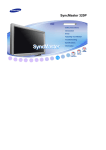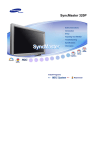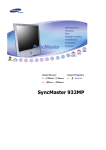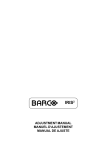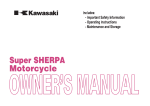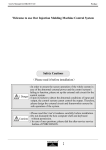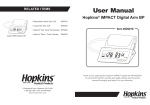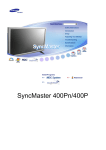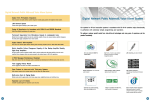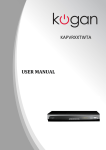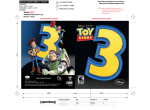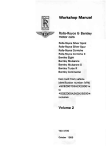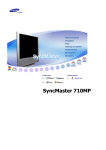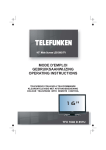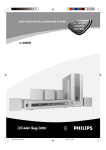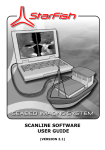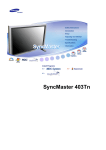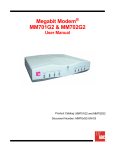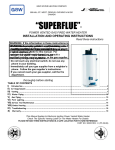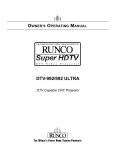Download Samsung 730MP Manual de Usuario
Transcript
Install Drivers
Install Programs
Failure to follow directions noted by this symbol could result in bodily harm or damage to
equipment.
Prohibited
Important to read and understand at all times
Do not disassemble
Disconnect the plug from the outlet
Do not touch
Grounding to prevent an electric shock
Power
When not used for extended period of time, set your computer to DPMS.
If using a screen saver, set it to the active screen mode.
Do not use a damaged or loose plug.
z
This may cause an electric shock or fire.
Do not pull the plug out by the wire nor touch the plug with wet hands.
z
This may cause an electric shock or fire.
Use only a properly grounded plug and receptacle.
z
An improper ground may cause electric shock or equipment damage.
Do not excessively bend the plug and wire nor place heavy objects upon them,
which could cause damage.
z
This may cause an electric shock or fire.
Do not connect too many extension cords or plugs to an outlet.
z
This may cause fire.
Installation
Put your monitor in a location with low humidity and a minimum of dust.
z
Failure to do so may cause an electric shock or fire inside the monitor.
Do not drop the monitor when moving it.
z
This may cause damage to the product or human body.
Place the monitor on a flat and stable surface.
z
The monitor may cause injury by falling.
Set down the monitor carefully.
z
The monitor could be damaged or broken.
Do not place the monitor face down.
z
The TFT-LCD surface may be damaged.
Installing a wall bracket must be done by a qualified professional.
z
z
Installation by unqualified personnel may result in injury.
Always use the mounting device specified in the owner's manual.
Leave a space for ventilation between the product and the wall.
z
Poor ventilation may cause the interior temperature to rise and lead to fire.
To prevent rainwater from running along the outdoor antenna cable and entering the
house, be sure the outdoor portion of the cable hangs down below the point of entry.
z
If rainwater enters the product, it may cause an electric shock or fire.
If you are using an outdoor antenna, be sure to put sufficient distance between your
antenna and the electrical wires nearby so that they would not come in contact with
each other in case the antenna is knocked over by strong wind.
z
A knocked-over antenna may cause injury or an electric shock.
Clean
When cleaning the monitor case or the surface of the TFT-LCD screen, wipe with a
slightly moistened, soft fabric.
Do not spray water or detergent directly on the monitor.
z
This may cause damage, electric shock or fire.
Use the recommended detergent with a smooth cloth.
If the connector between the plug and the pin is dusty or dirty, clean it properly
with a dry cloth.
z
A dirty connector may cause an electric shock or fire.
Contact a Service Center or Customer Center for interior cleaning once a year.
z
Keep the product's interior clean. Dust which has accumulated in the interior
over an extended period of time may cause malfunction or fire.
Others
Do not remove cover (or back). No user serviceable parts inside.
z
z
This may cause an electric shock or fire.
Refer servicing to qualified service personnel.
If your monitor does not operate normally - in particular, if there are any
unusual sounds or smells coming from it - unplug it immediately and contact
an authorized dealer or service.
z
This may cause an electric shock or fire.
Be careful not to let water drip into the monitor or expose the monitor to
moisture.
z
z
This may cause malfunction, an electric shock or fire.
Especially avoid operating the monitor near water or outdoors where it could be
exposed to snow or rain.
If the monitor is dropped or the casing is damaged, turn the monitor off and
unplug the power cord.
z
z
The monitor may malfunction, causing an electric shock or fire.
Then contact the Service Center .
Disconnect the plug from the outlet during storms or lightening or if it is not
used for a long period of time.
z
Failure to do so may cause an electric shock or fire.
Do not try to move the monitor by pulling only the wire or the signal cable.
z
This may cause a breakdown, electric shock or fire due to damage to the
cable.
Do not move the monitor right or left by pulling only the wire or the signal
cable.
z
This may cause a breakdown, electric shock or fire due to damage to the
cable.
Do not cover the vents on the monitor cabinet.
z
Bad ventilation may cause a breakdown or fire.
Do not place water containers, chemical products or small metal objects on the
monitor.
z
z
This may cause malfunction, an electric shock or fire.
If a foreign substance enters the monitor, unplug the power cord and contact
the Service Center .
Do not use or store inflammable substances near the monitor.
z
This may cause an explosion or fire.
Never insert anything metallic into the monitor openings.
z
This may cause an electric shock, fire or injury.
Do not insert metal objects such as utensils, wire or drill bits, or things that
catch fire easily, such as pieces of paper or matches, into the vents, or the
headphone, or A/V ports on the monitor.
z
z
This may cause malfunction, an electric shock or fire.
Always contact the Service Center if foreign substances/objects enter into the
monitor.
If you view a fixed screen for an extended period of time, residual image or
blurriness may appear.
z
Change the mode to energy save or set a screensaver to moving picture when
you need to be away from the monitor for an extended period of time.
Adjust the resolution and frequency to the levels appropriate for the model.
z
Inappropriate resolution may cause undesirable picture quality.
17 inch - 1280 X 1024
Keep the volume at a proper level when you use the headphones.
z
Excessively loud volume levels may damage hearing.
Keep a proper distance between your eyes and the monitor screen.
z
Sitting too close to the monitor on a continuous basis may damage eyesight.
To ease eye strain, take at least a five-minute break after every hour of using
the monitor.
Do not use the monitor where it may be exposed to strong vibrations.
z
Exposure to strong vibrations may be fire hazard and shorten the life of the
monitor.
When moving the monitor, turn the power switch off and unplug the power
cord.
Make sure that all cables, including the antenna cable and cables connecting to
other devices, are disconnected before moving the monitor.
z
Failure to disconnect a cable may damage it and lead to fire or an electric
shock.
When you remove batteries from the remote, be careful that they are not
swallowed by children. Keep batteries out of the reach of children.
z
If swallowed, see a doctor immediately.
When replacing batteries, place the batteries in the correct +/- polarity position
as indicated on battery holder.
z
Incorrect polarity may cause a battery to break or leak and could lead to fire,
injury, or contamination (damage).
Use only specified standard batteries. Do not use new and used batteries
together.
z
This may cause a battery to break or leak and could lead to fire, injury, or
contamination (damage).
Do not set a glass of water, chemicals or any small metal objects on the
monitor.
z
z
This may cause damage, electric shock or fire.
If a foreign substance gets into the monitor, disconnect the plug and then
contact a service center.
Please make sure the following items are included with your monitor.
If any items are missing, contact your dealer.
Contact a local dealer to buy optional items.
Unpacking
Option A
Monitor
Option B
Monitor & WISELINK
Manual
Quick Setup Guide
Cable(Option A)
Warranty Card
(Not available in all locations)
User's Guide, Monitor Driver,
Natural Color software
D-Sub Cable
Power Cord
Radio Antenna
Audio Cable
Audio Cable
Option B
USB Cable
D-Sub Cable
DVI Cable
Power Cord
Audio Cable
USB Cable
DVI Cable
Remote Control
Batteries (AAA X 2)
Connecter
Batteries (AAA X 2)
Connecter
Cable(Option B)
Sold separately
Radio Antenna
Others
Sold separately
Others
Option B
WISELINK
Front
Remote Control
1. MENU
2.
CH
3. + VOL -
Front
4. ENTER/FM RADIO
5. SOURCE
1.
MENU
6. PIP
2.
CH
7. Power
3.
- VOL +button
8. Power
indicator
4.
ENTER/FM
RADIO
5.
SOURCEControl Sensor
9. Remote
6. PIP
7. Power button
8. Power indicator
9. Remote Control Sensor
1. MENU
Use this button for open the on-screen menu and exits from the menu screen or closes
screen adjustment menu.
2.
CH
Moves from one menu item to another vertically or adjusts selected menu values. In TV
mode, selects TV channels.
>>Click here to see an animation clip
3. -+VOL
VOL +Moves from one menu item to another horizontally or adjusts selected menu values. Also
adjusts the audio volume.
>>Click here to see an animation clip
4. ENTER / FM RADIO
ENTER : Activates a highlighted menu item.
FM RADIO : Turns on/off FM Radio.
In PC/DVI mode, sets only SOUND to FM Radio.
In areas where signal is weak, noise may occur while FM radio is broadcast.
In general VIDEO SOURCE mode, sets to FM RADIO, turning off the screen.
>>Click here to see an animation clip
5. SOURCE
Switches from PC mode to Video mode.
Changing the source is allowed only external devices that are connected to the monitor at
the time.
To switch Screen modes:
[DVI]
[Ext.]
[PC]
[TV]
[AV]
[S-VIDEO]
[Component]
>>Click here to see an animation clip
NOTE : According to broadcasting type in each country, you may not be able to select one.
Scart is mainly used in Europe.
For more information > Broadcasting Systems
6. PIP ( Available in PC/DVI Mode Only )
In PC Mode, turns on Video or TV screens in PIP Mode.
>>Click here to see an animation clip
7. Power button
Use this button to turn the monitor on and off.
8. Power indicator
Power Indicator shows PowerSaver mode by green blinking.
9. Remote Control Sensor
Aim the remote control towards this spot on the Monitor.
See PowerSaver described in the manual for further information regarding power saving functions.
For energy conservation, turn your monitor OFF when it is not needed or when leaving it unattended
for long periods.
Rear
(The configuration at the back of the monitor may vary from product to product.)
1. Power
DC Power
Connection
Terminal
Connection
Terminal
This product may be used with 90 ~ 264VAC.
2. PC connection terminal
z
z
z
Computer connection terminal (DVI(HDCP))
Computer connection terminal(15 Pin D-SUB)
Audio connection terminal
3. COMPONENT
FM RADIO / TVterminal
connection terminal
z
z
z
z
FM RADIOleft
ANT
connection
terminal terminal (R/L)
DVD/DTV
/ right
audio connection
DVD/DTV Component(PR, PB,Y) terminal
TV connection terminal
For more information > Connecting TV
Headphone connection terminal (Output)
4. FM RADIO / TV connection terminal
TV connection terminal
For more information > Connecting TV
z FM RADIO ANT connection terminal
z Headphone connection terminal (Output)
EXT(RGB) connection terminal
z
4. EXT(RGB) connection terminal
- Scart is mainly used in Europe.
5. AV
connection
terminalterminal
EXT(RGB)
connection
EXT(RGB)
connection
terminal
z S-Video
connection
terminal (Input)
- Scart is mainly used in Europe.
z Video connection terminal (Input)
z
Left(L) / Right(R) audio connection terminal (Input)
z
Left(L) / Right(R) AUDIO connection terminal (Input)
6. AV connection terminal
See Connecting the Monitor for further information
cable
connections.
VIDEOregarding
connection
terminal
(Input)
z
z
S-VIDEO connection terminal (Input)
See Connecting the Monitor for further information regarding cable connections.
Remote Control
1. POWER
2. CHANNEL
3. +100, -/-4. -
+
5. MUTE
6. TTX/MIX
7. MENU
8. ENTER
9. FM RADIO
10. CH/P
Remote Control
11. SOURCE
12.
1.
13.
2.
14.
3.
15.
4.
16.
INFO
POWER
EXIT
CHANNEL
Up-Down Left-Right Buttons
+100, -/-AUTO
+
P.MODE, M/B (MagicBright™)
17.
P.SIZE
5. MUTE
18.
STILL
6. TTX/MIX
7. PIP
MENU
19.
20.
8. S.MODE
ENTER
21.
9. DUAL/MTS
FM RADIO
22. PRE-CH
10.
CH/P
23. SOURCE
11.
24. SIZE
12.
INFO
25. POSITION
13.
EXIT
14.
Up-Down Left-Right Buttons
26. MAGIC-CH
15. AUTO
1. POWER
Use this button to turn the monitor on and off.
16. P.MODE, M/B (MagicBright™)
17. P.SIZE
2. CHANNEL
18. STILL
Selects TV channels in the TV mode. You may use19.
this PIP
button in PIP mode as well.
20. S.MODE
3. +100
Press to select channels over 100.
21. DUAL/MTS
For example, to select channel 121, press "+100", then press "2" and "1".
22. PRE-CH
-/-- (One/Two-Digit channel selection )
23. SOURCE
Use to select a channel numbered ten or over.
Press this button, and the "--" symbol is displayed. 24. SIZE
Enter the two-digit channel number.
25. POSITION
4. +
26. MAGIC-CH
Adjusts the audio volume.
1. MUTE
POWER
5.
Use this(mutes)
button to
turn
the output
monitortemporarily.
on and off.
Pauses
the
audio
Displays on the lower left corner of the screen.
2. The
CHANNEL
audio resumes if Mute or + is pressed in the Mute mode.
Selects TV channels in the TV mode. You may use this button in PIP mode as well.
6. TTX/MIX
3. TV
+100
channels provide written information services via teletext.
Press
to select
channels
over/ MIX
100.
For
more
information
> TTX
For example,
to select
channel
121, press "+100", then press "2" and "1".
TTX
/ MIX is mainly
used
in Europe.
-/-- (One/Two-Digit channel selection )
7. MENU
Use to select a channel numbered ten or over.
Pressthis
thisbutton
button,
symbol ismenu
displayed.
Use
to and
openthe
the"--"
on-screen
and exit from the menu screen or close screen
Enter the two-digit
adjustment
menu. channel number.
-/-- is mainly used in Europe.
8. ENTER
4. Activates
+
a highlighted menu item.
Adjusts the audio volume.
9. FM RADIO
5. Turns
MUTEon/off FM Radio.
Pauses
(mutes)
audio
temporarily.
In
PC/DVI
mode,the
sets
onlyoutput
SOUND
to FM Radio.
Displays
on the signal
lower is
leftweak,
corner
of the
screen.
In
areas where
noise
may
occur while FM radio is broadcast.
The
audio VIDEO
resumesSOURCE
if Mute ormode,
+sets
is pressed
in the Mute
mode.
In
general
to FM RADIO,
turning
off the screen.
6. CH/P
TTX/MIX
10.
TVTV
channels
provideTV
written
information services via teletext.
In
mode, selects
channels.
For more information > TTX / MIX
TTX / MIX is mainly used in Europe.
11. SOURCE
Switches from PC mode to Video mode.
7. Changing
MENU
the source is allowed only external devices that are connected to the monitor at
Usetime.
this button to open the on-screen menu and exit from the menu screen or close screen
the
adjustment menu.
12. INFO
8. Current
ENTER picture information displays on the upper left corner of the screen.
Activates a highlighted menu item.
13. EXIT
9. Exits
FM RADIO
from the menu screen.
Turns on/off FM Radio.
PC/DVI Left-Right
mode, sets Buttons
only SOUND to FM Radio.
14. In
Up-Down
In areasfrom
where
weak,
noise may
occur while
FM radio
broadcast.
Moves
onesignal
menuisitem
to another
horizontally,
vertically
or is
adjusts
selected menu
In general VIDEO SOURCE mode, sets to FM RADIO, turning off the screen.
values.
10. AUTO
CH/P
15.
In TV mode,
selectsdisplay
TV channels.
Adjusts
the screen
automatically.
11. SOURCE
16.
P.MODE, M/B (MagicBright™)
When
youfrom
press
button,
current
mode is displayed on the lower center of the screen.
Switches
PCthis
mode
to Video
mode.
Changing the source is allowed only external devices that are connected to the monitor at
the /time.
TV
AV / Ext. / S-Video /Component Mode : P.MODE( Picture Mode )
The Monitor has four automatic picture settings that are preset at the factory.
12. Then
INFO push button again to circle through available preconfigured modes.
(Current
Dynamic
Standard displays
Movieon the Custom
picture information
upper left) corner of the screen.
PC / DVI Mode : M/B ( MagicBright™ )
13. EXIT
MagicBright™
is a new
feature providing the optimum viewing environment depending on
Exits from the menu
screen.
the contents of the image you are watching.
pushLeft-Right
button again
to circle through available preconfigured modes.
14. Then
Up-Down
Buttons
( Entertain
Internet
Text
Custom )
Moves from one menu item to another horizontally, vertically or adjusts selected menu
values. - Not available in PC/DVI Mode
17. P.SIZE
15. Press
AUTOto change the screen size.
ZOOM1, ZOOM2 are not available in 1080i(or over 720p) of DTV.
Adjusts the screen display automatically.(PC MODE)
18. STILL
16. P.MODE, M/B (MagicBright™)
Press the button once to freeze the screen. Press it again to unfreeze.
When you press this button, current mode is displayed on the lower center of the screen.
19. PIP
TV / AV / Ext. / S-Video /Component Mode : P.MODE( Picture Mode )
Push
the PIPhas
button
turn PIP picture
screen settings
On/Off. that are preset at the factory.
The Monitor
fourtoautomatic
Then push button again to circle through available preconfigured modes.
20. (S.MODE
Mode )
Dynamic( Sound
Standard
Movie
Custom )
When you press this button, current mode is displayed on the lower center of the screen.
The
has: aM/B
built-in
high fidelity stereo
amplifier.
PC / Monitor
DVI Mode
( MagicBright™
)
Then
push button
to circleproviding
through available
preconfigured
modes. depending on
MagicBright™
is aagain
new feature
the optimum
viewing environment
(the
Standard
Music
Movie
Speech
Custom )
contents of the
image you
are watching.
Then push button again to circle through available preconfigured modes.
21. DUAL
/ MTS Internet
( Entertain
Text
Custom )
DUAL : STEREO/MONO, DUAL l / DIAL ll and MONO/NICAM MONO/NACAM STEREO
17. can
P.SIZE
- Not available
in PC/DVI
Mode
be operated
depending
on broadcasting
type by using DUAL button on the remote
controltowhile
watching
TV. size.
Press
change
the screen
Toggles MONO/STEREO,
DUAL 1/DUAL
2 and
MONO/NICAM
MONO/NICAM STEREO
ZOOM1,
ZOOM2 are not available
in 1080i(or
over
720p) of DTV.
MTS : You can select the MTS (Multichannel Television Stereo) mode.
Mono, Stereo, SAP (Separate Audio Program)
18. •STILL
Set 'MTS'
to ON to
choose
Mono,
or Press
SAP. it again to unfreeze.
Press
the button
once
to freeze
theStereo
screen.
22.
19. PRE-CH
PIP
This button
is button
used totoreturn
to the
immediately
Push
the PIP
turn PIP
screen
On/Off. previous channel.
23.
20. SOURCE
S.MODE ( Sound Mode )
Selectsyou
thepress
Videothis
source.
When
button, current mode is displayed on the lower center of the screen.
The Monitor has a built-in high fidelity stereo amplifier.
24. Then
SIZE push button again to circle through available preconfigured modes.
can switch the
Picture Size.
(You
Standard
Music
Movie
Speech
Custom )
25.
21. POSITION
DUAL / MTS
Changing
the Position of the
PIP lwindow.
DUAL
/ DIAL ll and MONO/NICAM MONO/NACAM STEREO
DUAL
: STEREO/MONO,
can be operated depending on broadcasting type by using DUAL button on the remote
26. MAGIC-CH
control while watching TV.
MagicChannel
enables youDUAL
to watch
only certain
channels.
Toggles
MONO/STEREO,
1/DUAL
2 and MONO/NICAM
MONO/NICAM STEREO
the MTS
This function
available
only(Multichannel
in Korea. Television Stereo) mode.
MTS
: You canisselect
• Mono, Stereo, SAP (Separate Audio Program)
Set 'MTS' to ON to choose Mono, Stereo or SAP.
22. PRE-CH
This button is used to return to the immediately previous channel.
23. SOURCE
Selects the Video source.(PIP Mode)
24. SIZE
You can switch the Picture Size.
25. POSITION
Changing the Position of the PIP window.
26. MAGIC-CH
MagicChannel enables you to watch only certain channels.
This function is available only in Korea.
Connecting the monitor
1. Connecting to a Computer
1.
Connect the power cord for your monitor to the power port on the back of the monitor.
Plug the power cord for the monitor into a nearby outlet.
2-1.
Using the D-sub (Analog) connector on the video card.
Connect the signal cable to the 15-pin, D-sub connector on the back of your monitor.
2-2.
Using the DVI (Digital) connector on the video card.
Connect the DVI Cable to the DVI Port on the back of your Monitor.
3.
Connect the audio cable for your monitor to the audio port on the back of your computer.
4.
Connect
the power
cord insert
a plug
in a wall outlet.
Turn
on both
your computer
and
the monitor.
5.
Turnmay
on both
your
computer
and sound
the monitor.
You
enjoy
clear
and quality
from the computer sound card using the monitor speakers.
(You don't need to install any separate speakers for your computer.)
You may enjoy clear and quality sound from the computer sound card using the monitor speakers.
(You don't need to install any separate speakers for your computer.)
6.
You may get a blank screen depending on the type of video card you are using, if you connect
simultaneously both the D-sub and DVI cables to one computer.
You may get a blank screen depending on the type of video card you are using, if you connect
simultaneously both the D-sub and DVI cables to one computer.
If you connect properly your monitor using the DVI connector but get a blank or fuzzy screen, check
If you
properly
yourismonitor
using the Press
DVI connector
but gettoahave
blankthe
or monitor
fuzzy screen,
check
to
seeconnect
if the monitor
status
set to analogue.
Source button
doubleto see the
if the
monitor
status
is set to analogue. Press Source button to have the monitor doublecheck
input
signal
source.
check the input signal source.
2. Connecting to a Macintosh
2. Connecting to a Macintosh
1. Connect the power cord to the DC adapter and then connect the adapter jack to the DC POWER
1. Connect the power cord to the DC adapter and then connect the adapter jack to the DC POWER
port on the monitor. (Voltage is automatically adjusted by the power adapter.)
port on the monitor. (Voltage is automatically adjusted by the power adapter.)
2. Using the D-sub (Analog) connector on the video card.
2. Using the D-sub (Analog) connector on the video card.
Connect the signal cable to the D-SUB port on the Macintosh computer.
Connect the signal cable to the D-SUB port on the Macintosh computer.
3. For older model Macintoshes, you need to adjust the resolution control DIP switch on the Macintosh
3. adapter
For older(optional)
model Macintoshes,
youswitch
need to
adjust the resolution
control
DIP
switch on the Macintosh
referring to the
configuration
table shown
on its
rear.
adapter (optional) referring to the switch configuration table shown on its rear.
4. Connect the audio cable for your monitor to the audio port on the back of your computer.
4. Turn on the monitor and Macintosh.
5. Turn on the monitor and Macintosh.
Connecting to other devices
Connecting
to other
This monitor
allowsdevices
the user to connect it to such input devices as a DVD player, a VCR or a
camcorder, or a DTV or a TV without disconnecting the PC. For detailed information on connecting
This monitor allows the user to connect it to such input devices as a DVD player, a VCR or a
AV input devices, refer to User Controls under Adjusting Your Monitor.
camcorder, or a DTV or a TV without disconnecting the PC. For detailed information on connecting
AV input
devices, refer
UserofControls
under
Adjusting
Your
Monitor.
The
configuration
at thetoback
the monitor
may
vary from
product
to product.
The configuration at the back of the monitor may vary from product to product.
1-1. Connecting AV Devices
The monitor
has AV connection terminals to connect AV input devices like DVDs, VCRs or
1-1. Connecting
AV Devices
Camcorders. You may enjoy AV signals as long as the monitor is turned on.
The monitor has AV connection terminals to connect AV input devices like DVDs, VCRs or
Camcorders. You may enjoy AV signals as long as the monitor is turned on.
1. Input devices such as DVDs, VCRs or Camcorders are connected to the Video or S-Video terminal
of the monitor using the RCA or S-Video cable.
S-Video, RCA cable and EXT(RGB) cable is optional.
2. Then, start the DVD, VCR or Camcorders with a DVD disc or tape inserted.
3. Select AV or S-Video using the SOURCE button on the monitor's front.
4. Connect the Audio (R) and Audio (L) terminals of a DVD, VCR or Camcorders to the monitor's R
and L audio input terminals using audio cables.
1-2. Connecting EXT(RGB) - It only applies to AV DEVICE that supports SCART.
Connect to the DVD Devices input if the device has a DVD connector.You can watch DVD simply by
hooking up the DVD with the monitor as long as the power is on.
1. Connect a video cable between the EXT(RGB) jacks on the Monitor and the EXT(RGB) jacks on
the DVD Player.
2. Select Ext. by pressing SOURCE button on the monitor.
2. Connecting TV
You may view television programs on the monitor if it is connected to an antenna or a CATV cable
without installing any separate TV reception hardware or software on your computer.
1. Connect the CATV or antenna coaxial cable to the Antenna terminal on the rear of the monitor.
You need to use a coaxial antenna cable.
When using an interior antenna terminal:
Check the antenna terminal on the wall first and connect the antenna cable.
When using an outdoor antenna:
If you are using an outdoor antenna, use a professional for installation if possible.
To connect the RF cable to the antenna input terminal:
Keep the copper wire portion of the RF cable straight.
2. Turn on the monitor.
3. Select TV using Source button among the external signal adjustment buttons.
4. Select a desired TV channel.
Is weak signal causing poor reception?
Purchase and install a signal amplifier for better reception.
In areas where Antenna cable is not supported, first, attach Connecter to TV antenna .
3. Connecting DVD/DTV Set Top Box
Connect to the DVD/DTVSet Top Box input if the device has a DVD/DTV connector. You can watch
Component simply by hooking up the Component with the monitor as long as the power is on.
1. Connect the Audio (R) and Audio (L) outputs on the DVD / DTV set top box to the Audio (R) and
Audio (L) inputs on the monitor using audio cables.
2. Connect a video cable between the component( PRR, PBB,Y) jacks on the Monitor and the PRR, PBB,Y
jacks on the DVD / DTV set top box.
3. Select Component using the SOURCE button on the monitor's front.
4. Connecting Headphone
You may connect your Headphone to the monitor.
1. Connect your Headphone to the Headphone connection terminal.
Using the Stand
This monitor supports various types of VESA-standard bases. You need to either fold or remove the
base in use in order to install a VESA base.
1. Folding the base
The monitor may be reclined from -5 to 15 degrees.
2. Attaching a base
This monitor accepts a 75 mm x 75 mm VESA-compliant mounting interface pad.
A. Monitor
B. Mounting interface pad
1.
2.
3.
4.
Turn off your monitor and unplug its power cord.
Lay the LCD monitor face-down on a flat surface with a cushion beneath it to protect the screen.
Remove four screws and then remove the Stand from the LCD monitor.
Align the Mounting Interface Pad with the holes in the Rear Cover Mounting Pad and secure it with
four screws that came with the arm-type base, wall mount hanger or other base.
To mount the monitor on a wall, you should purchase the wall mounting kit that allows you to mount the
monitor at least 10cm away from the wall surface. Contact the nearest Samsung Service Center for
more information.
Samsung Electronics will not be responsible for damages caused by using a base other than those
specified.
When prompted by the operating system for the monitor driver, insert the CD-ROM included
with this monitor. Driver installation is slightly different from one operating system to
another. Follow the directions appropriate for the operating system you have.
Prepare a blank disk and download the driver program file at the Internet web site shown here.
z
Internet web site :
http://www.samsung-monitor.com/ (Worldwide)
http://www.samsungusa.com/monitor (USA)
http://www.sec.co.kr/monitor (Korea)
http://www.samsungmonitor.com.cn/ (China)
Windows ME
1. Insert CD into the CD-ROM drive.
2. Click "Windows ME Driver".
3. Choose your monitor model in the model list, then click the "OK" button.
4. Click the "Install" button in the "Warning" window.
5. Monitor driver installation is completed.
Windows XP/2000
1. Insert CD into the CD-ROM drive.
2. Click "Windows XP/2000 Driver"
3. Choose your monitor model in the model list, then click the "OK" button.
4. If you can see following message window, then click the "Continue Anyway" button. Then
click "OK" button.
This monitor driver is under certified MS logo,and this installation doesn't damage
your system.The certified driver will be posted on Samsung Monitor homepage.
http://www.samsung-monitor.com/.
5. Monitor driver installation is completed.
Windows XP | Windows 2000 |Windows Me |Windows NT | Linux
When prompted by the operating system for the monitor driver, insert the CD-ROM included
with this monitor. Driver installation is slightly different from one operating system to
another. Follow the directions appropriate for the operating system you have.
Prepare a blank disk and download the driver program file at the Internet web site shown here.
z
Internet web site :
http://www.samsung-monitor.com/ (Worldwide)
http://www.samsungusa.com/monitor (USA)
http://www.sec.co.kr/monitor (Korea)
http://www.samsungmonitor.com.cn/ (China)
Microsoft® Windows® XP Operating System
1. Insert CD into the CD-ROM driver.
2. Click "Start" —> "Control Panel" then click the "Appearance and Themes" icon.
3. Click "Display" icon and choose the "Settings" tab then click "Advanced..".
4. Click the "Properties" button on the "Monitor" tab and select "Driver" tab.
5. Click "Update Driver.." and select "Install from a list or.." then click "Next" button.
6. Select "Don't search ,I will.." then click "Next" and then click "Have disk".
7. Click the "Browse" button then choose A:(D:\Driver) and choose your monitor model in the model list
and click the "Next" button.
8. If you can see following message window, then click the "Continue Anyway" button. Then click "OK"
button.
This monitor driver is under certified MS logo,and this installation doesn't damage your system.The
certified driver will be posted on Samsung Monitor homepage.
http://www.samsung-monitor.com/
9. Click the "Close" button, then click "OK" button continually.
10. Monitor driver installation is completed.
Microsoft® Windows® 2000 Operating System
When you can see "Digital Signature Not Found" on your monitor, follow these steps.
1. Choose "OK" button on the "Insert disk" window.
2. Click the "Browse" button on the "File Needed" window.
3. Choose A:(D:\Driver) then click the "Open" button and then click "OK" button.
How to install
1.
2.
3.
4.
5.
6.
7.
8.
9.
10.
Click "Start" , "Setting" , "Control Panel".
Double click the "Display" Icon.
Choose the "Settings" tab and then click "Advanced..".
Choose "Monitor".
Case1: If the "Properties" button is inactive, it means your monitor is properly configured. Please
stop installation
Case2: If the "Properties" button is active, click the "Properties" button then follow next steps
continually.
Click "Driver" and then click on "Update Driver.." then click on the "Next" button.
Choose "Display a list of the known drivers for this device so that I can choose a specific
driver" then click "Next" and then click "Have disk".
Click the "Browse" button then choose A:(D:\Driver).
Click the "Open" button, then click "OK" button.
Choose your monitor model and click the "Next" button then click "Next" button.
Click the "Finish" button then the "Close" button.
If you can see the "Digital Signature Not Found" window then click the "Yes"button. And click
the "Finish" button then the "Close" button.
Microsoft® Windows® Millennium Operating System
1.
2.
3.
4.
5.
6.
7.
8.
9.
10.
Click "Start" , "Setting" , "Control Panel".
Double click "Display" icon.
Select the "Settings" tab and click "Advanced Properties" button.
Select the "Monitor" tab.
Click the "Change" button in the "Monitor Type" area.
Choose "Specify the location of the driver".
Choose "Display a list of all the driver in a specific location.." then click "Next" button.
Click the "Have Disk" button
Specify A:\(D:\driver) then click "OK" button.
Select "Show all devices" and choose the monitor that corresponds to the one you connected to
your computer and click "OK".
11. Continue choosing "Close" button and "OK" button until you close the Display Properties dialogue
box.
Microsoft® Windows® NT Operating System
1. Click Start, Settings, Control Panel, and then double-click Display icon.
2. In Display Registration Information window, click Settings Tab and then click All Display Modes.
3. Select a mode that you wish to use (Resolution, Number of colors and Vertical frequency) and then
click OK.
4. Click Apply button if you see the screen working normally after clicking Test. If the screen is not
normal, change to a different mode (lower mode of resolution, colors or frequency).
If there is no Mode at All Display Modes, select the level of resolution and vertical frequency
by referring to the Preset Timing Modes in the user guide.
Linux Operating System
To execute X-Window, you need to make the X86Config file, which is a type of system setting file.
1.
2.
3.
4.
5.
6.
7.
8.
9.
Press Enter at the first and the second screen after executing the X86Config file.
The third screen is for setting your mouse.
Set a mouse for your computer.
The next screen is for selecting a keyboard.
Set a Keyboard for your computer.
The next screen is for setting your monitor.
First of all, set a horizontal frequency for your monitor. (You can enter the frequency directly.)
Set a vertical frequency for your monitor. (You can enter the frequency directly.)
Enter the model name of your monitor. This information will not affect the actual execution of XWindow.
10. You have finished setting up your monitor.
Execute X-Window after setting other requested hardware.
Natural
Natural Color
Color
Natural Color Software Program
One of the recent problems in using a computer is that the color of the images printed out by a printer
or other images scanned by a scanner or a digital camera are not the same as those shown on the
monitor.
The Natural Color S/W is the very solution for this problem. It is a color administration system
developed by Samsung Electronics in association with Korea Electronics & Telecommunications
Research Institute (ETRI).
This system is available only for Samsung monitors and makes the color of the images on the monitor
the same as the printed or scanned images.
For more information, refer to Help (F1) in the software program.
How to install the Natural Color software
Insert the CD included with the Samsung monitor into the CD-ROM Drive. Then, the initial screen of the
program Natural Color will be executed. Click Natural Color on the initial screen to install the Natural
Color software.
To install the program manually, insert the CD included with the Samsung monitor into the CD-ROM
Drive, click the [Start] button of Windows and then select [Execute].
Enter D:\color\eng\setup.exe and then press the <Enter> key.
(If the drive where the CD is inserted is not D:\, enter the applicable drive.)
How to delete the Natural Color software program
Select "Setting" / 'Control Panel" on the "Start" menu and then double-click "Add/Delete a
program".
Select Natural Color from the list and then click the [Add/Delete] button.
Input
Available Mode
OSD
: PC / DVI
: TV
: AV
: S-Video
Description
Source Use to select PC, TV or other external input source
connected to the Monitor.
Use to select the screen of your choice.
• PC
• DVI: HDCP supported
• TV
• Ext.- EXT.(RGB)is mainly used in Europe.
• AV
• S-Video
• Component
PIP
When external A/V devices such as VCRs or DVDs are
connected to the monitor, PIP allows you to watch video from
those devices in a small window super-imposed on the PC
Video signal. (On/Off)
While V-chip is in operation, the PIP function cannot be
used.
- Available in PC Mode Only
: Component
Play
1) PIP
• ON/ Off
: Turn the PIP Screen on or off.
2) Source
• PC / DVI
: TV / Ext.(EXT.(RGB)is mainly used in Europe.) / AV / S-Video / Component
Mode
: Select the input source for the PIP.
3) Size
: Change the Size of the PIP window.
If you select
,
in Size, Position and Transparency
will not be activated.
1) PIP
2) Source
3) Size
4) Position
5)
Transparency
4) Position
: Change the Position of the PIP window.
5) Transparency
• High / Medium / Low / Opaque
: Adjust the Transparency of PIP windows.
Edit
Name
Name the input device connected to the input jacks to make
your input source selection easier.
• PC
• DVI
• Ext. - EXT.(RGB)is mainly used in Europe.
• AV
• S-Video
• Component
Picture
PC / DVI Mode
When you input video signal into DVI, TV / AV / S-Video / Component Modewill appear in the menu.
Available Mode
OSD
Description
: PC / DVI
: TV
: AV
: S-Video
: Component
Play
MagicBright™ MagicBright™ is a new feature providing the optimum
viewing environment depending on the contents of the image
you are watching.
Currently four different modes are available: Entertain,
Internet,Text and Custom.
Each mode has its own pre-configured brightness value. You
can easily select one of four settings by simply pressing the
MagicBright™ control button.
1) Entertain
: High Brightness
For watching motion pictures such as a DVD or VCD.
2) Internet
: Medium Brightness
For working with a mixture of images such as text and graphics.
3) Text
: Normal Brightness
For documentations or works involving heavy text.
4) Custom
Although the values are carefully chosen by our engineers, the preconfigured values may not be comfortable to your eyes depending on your
taste.
If this is the case, adjust the Brightness and Contrast by using the OSD
menu.
Custom
You can use the on-screen menus to change the contrast
and brightness according to personal preference.
1) Contrast
: Adjust the Contrast.
2) Brightness
: Adjust the Brightness.
If you adjust picture using Custom function, MagicBright will turn to Custom mode.
Color Tone
The tone of the color can be changed.
- Available in PC Mode Only
• Cool / Normal / Warm / Custom
Color Control
Adjust the individual R, G, B color controls.
- Available in PC Mode Only
1) Red
2) Green
3) Blue
If you adjust picture using Color Control function, Color Tone will turn to Custom mode.
Image Lock
Image Lock is used to fine-tune and get the best image by
removing noise that creates unstable images with jitter and
shimmer. If satisfactory results are not obtained using the
Fine adjustment, use the Coarse adjustment and then use
Fine again.
- Available in PC Mode Only
1) Coarse
: Removes noise such as vertical stripes. Coarse adjustment may move
the screen image area. You may relocate it to the center using the
Horizontal Control menu.
2) Fine
: Removes noise such as horizontal stripes. If the noise persists even after
Fine tuning, repeat it after adjusting the frequency (clock speed).
3) Position
: Adjusts the screen location horizontally and vertically.
Auto
Adjustment
The values of Fine, Coarse, position are adjusted
automatically.
If you change resolution in the control panel, Auto function
will be executed.
- Available in PC Mode Only
PIP Picture
You can adjust the PIP Screen Settings.
1) Contrast
: Adjusts the Contrast of the PIP window on the screen.
2) Brightness
1) Coarse
/ Fine
3)
Position
: Adjusts the Brightness of the PIP window on the screen.
3) Sharpness
: Adjusts the difference between the lightest and darkest areas of the PIP
window.
4) Color
: Adjusts the Color of the PIP window on the screen.
5) Tint
: Adds a natural tone to the PIP window.
Available : PIP ON
TV / Ext. / AV / S-Video / Component Mode
Available Mode
: PC / DVI
: TV
: AV
: S-Video
: Component
OSD
Description
Mode
The Monitor has four automatic picture settings ("Dynamic",
"Standard", "Movie" and "Custom") that are preset at the
factory.
You can activate either Dynamic, Standard, Movie, or
Custom. You can select "Custom" which automatically recalls
your personalized picture settings.
• Dynamic
• Standard
• Movie
• Custom
Custom
You can use the on-screen menus to change the contrast
and brightness according to personal preference.
1) Contrast
: Adjusts the Contrast.
2) Brightness
: Adjusts the Brightness.
3) Sharpness
: Adjusts the difference between the lightest and darkest areas of the
display.
4) Color
: Adjusts the Color of the PIP window on the screen.
5) Tint
: Adds a natural tone to the display.
Color Tone The tone of the color can be changed. The individual color
components are also user adjustabls.
• Cool2 / Cool1 / Normal / Warm1 / Warm2
Size
You can switch the Size.
• 16:9
Play
• Normal
• Zoom 1
• Zoom 2
- ZOOM1, ZOOM2 are not available in 1080i(or over 720p) of DTV.
Digital NR
- Digital Noise Reduction.
You can turn the Noise Elimination feature On/Off.
The Digital Noise Elimination feature allows you to enjoy
clearer and crisper images.
• On /Off
Film Mode
You can turn Film Mode On/Off.
The Film Mode feature offers you a theater-quality viewing
experience.
• On /Off
Sound
Available Mode
: PC / DVI
: TV
: AV
: S-Video
OSD
Description
Mode
The Monitor has a built-in high fidelity stereo amplifier.
1) Standard
: Choose Standard for the standard factory settings.
2) Music
: Choose Music when watching music videos or
concerts.
3) Movie
: Choose Movie when viewing movies.
4) Speech
: Choose Speech when watching a show that is mostly
dialogue (i.e., news).
5) Custom
: Choose Custom if you want to adjust the settings
according to personal preference.
Custom
The sound settings can be adjusted to suit your personal
: Component
Play
preference.
1) Bass
: Emphasize low frequency audio.
2) Treble
: Emphasize high frequency audio.
3) Balance
: Allows you to adjust the sound balance between the left and right
speakers.
Auto
Volume
Reduces the differences in volume level among
broadcasters.
• On /Off
Dolby
Virtual
Dolby Virtual Sound On/Off (Dolby Virtual simulates the effect
of the Dolby Surround sound system, recreating the movietheatre or concert-hall- quality sound.)
• On /Off
BBE
BBE (Barcus-Berry Electronics) recreates the natural sound
and improves sound clarity through boosting high and low
range frequencies.
As a result, high sounds are clearer, brilliant and finely
detailed while low sounds are tight, well-defined and
harmonically rich.
• On /Off
BBE and Dolby Virtual cannot be functioned at the same time.
Select
Sound
You can select either Main or Sub when PIP is On.
• Main / Sub
Available : PIP ON
FM Radio
Press the button on the front or the "FM RADIO" button on
the remote control to select the "FM RADIO" feature.
• Auto Store
You can scan the frequency ranges available on your
FM Radio in your area and store all the channels found
automatically.
• Manual Store
You can scan the frequency ranges available on your
FM Radio in your area and store all the channels found
manually.
- Channel : Chooses the Radio channel through the
adjustment of up/down under the current frequency.
- Search : The tuner scans the frequency range until
the first channel or the channel that you selected is
received.
- Store : Restores the number user inputs.
• Add / Delete
Adds or deletes channels from the memory.
If you select FM Radio, picture will turn black
while FM Radio is functioning in TV, EXT,
AV, S-Video, Component modes except PC,
DVI modes.
Available : FM Radio ON
Channel
Auto Store
Manual Store
Add / Delete
Available Mode
: PC / DVI
: TV
: AV
: S-Video
OSD
Description
Auto
Program
The TV automatically cycles through all of the available
channels and stores them in memory. This takes about one
to two minutes.
In rare cases, "Auto program" may miss a few channels due
to weak signals and the channels may not be added to the
channel memory.
Add/Delete
Adds or deletes channels from the memory.
Fine Tune
Due to weak signals or an incorrect antenna configuration,
some of the channels may not be tuned correctly.
LNA
Amplifies signals when antenna reception is poor. However, if
incoming signals are interfering with each other, turn off LNA
as it may malfunction.
• On / Off
Setup
: Component
Play
Available Mode
OSD
: PC / DVI
: TV
: AV
: S-Video
: Component
Description
Play
When you turn the power on of the product for the first time since it released
Area
Configuration from a factory, menu to select location will appear.
Choose the region and country where you use the monitor.
This is because broadcasting type varies according to region and country.
You can select broadcasting type in OSD menu as well by selecting MENUSetup-Area Configuration.
Note : This product can be used worldwide if area configuration is set up
regardless of broadcasting type.
Note : If country is not selected properly, the product may not locate
channels.
Language
You can choose one of 2 languages.
• English, 한국어
Note : The language chosen affects only the language of the
OSD.
It has no effect on any software running on the computer.
Sleep Timer
Use to set the Monitor to be turned off automatically the set in
certain minutes.
(Off, 30, 60, 90, 120, 150, 180)
Caption
Enables or disables the Caption feature and sets the
appearance of closed caption text.
1) Caption : Off / On
2) Mode : Caption / Text
3) Channel : 1 / 2
4) Field : 1 / 2
Changes the opaqueness of the background of the OSD.
Menu
Transparency
• High
• Medium
• Low
• Opaque
Blue Screen
If no signal is being received or the signal is very weak, a
blue screen automatically replaces the noisy picture
background. If you wish to continue viewing the poor picture,
you must set the "Blue screen" mode to "Off".
• On / Off
Reset
Picture parameters are replaced with the factory default
values.
- Available in PC Mode Only
1) Image Reset
2) Color Reset
1) Image
Reset
2) Color Reset
MagicChannel
MagicChannel : ON l OFF l RESET l PASSWORD
MagicChannel enables you to watch only certain channels.
Parents can help their children study more effectively by selectiong channels only related to learning.
Be careful not to misplace the remote control since without it, to select or cancel
MagicChannel is impossible.
If you don't remember your pin number, turn the power off and press 'MUTE+8+2+4'(press each
key within 2 seconds' interval) and then turn on the power to initialize the pin number.
MagicChannel should be operated only after channels are selected by Auto store Seletion.
MaginChannel cannot be operated while other external devices are connected.
MaginChnannel perfomes better when the remote control is closer to the sensor.
Overview
Setup
OSD Mode
Troubleshooting
Using WISELINK
WISELINK is used to play Photo Files (*.jpg), Music Files (*.mp3, *.wav) and Movie Files (*.avi, *.mov)
stored in the memory card on the Monitor.
What is a Memory Card?
A memory card is an auxiliary storage device used in AV equipment to exchange data between devices.
It is mainly used in digital cameras, digital camcorders,MP3 players, notebooks, and PDAs.
Memory Cards Available in WISELINK
You can use CF (Compact Flash), SMC (Smart Media Card), SD (Secure Digital),MMC (Multi Media Card),
and MS (Memory Stick) in the four WISELINK slots. Confirm the card type and proper insertion direction
before you insert a memory card. The correct card type is listed for each slot.
Compact Flash I
Multimedia Card
(MMC)
Memory Stick
Secure Digital Card
(SD Card)
Smart Media Card
If your computer is not running Windows XP, you must install the driver from the CD included
with the product to run the card driver properly.
Notes: Memory Stick Pro and Memory Stick Duo are not supported.
There are different slot configurations for Compact Flash Type I and II. This product supports CF Type I.
z
z
How to Insert a Memory Card
Gently push the memory card into the slot. If the card is not inserted completely, it will not work.
Insert the card in the direction indicated on the memory card.
Note: Do not apply excessive force while inserting the card.
How to eject a Memory Card
Holding the tip of the card, gently pull it out.
Cautions on Memory Card Use
- Data can be damaged when a memory card is used in the presence of static electricity and/or electronic
noise.
- Data can be damaged when a memory card is repeatedly inserted and ejected.
- Play speed may differ depending on the card type.
- Do not attach anything but a label in the proper place.
- Be careful to attach the label only within the proper space.
- Be careful not to make contact between the memory card terminal and metal objects.
- Do not strike, bend or drop the memory card.
- Do not dismantle or tinker with the memory card.
- Be careful to keep the memory card dry.
Cautions on using WISELINK Mode
-
Do not insert foreign objects into the slot.
Insert the memory card in the proper direction
Do not remove the memory card when it is in use.
The manufacturer's responsibility does not include damaged data.
(Be careful not to corrupt data and be sure to back up files.)
- Use the slot cover so that dust and foreign objects cannot enter the slot when WISELINK is not in use.
Initialization of WISELINK Mode
Errors can occur in WISELINK mode because of the various memory card types, the various manufacturers
and the type of data stored.When an error occurs, please initialize WISELINK as follows:
Method :
After pressing the SOURCE button to switch into another mode, press the SOURCE button
again to return to WISELINK mode. Initialization is now finished.
Files supported by WISELINK
Photo Files
(*.jpg)
File Type
Music Files
(*.mp3, *.wav)
Movie Files
(*.avi, *.mov)
File Size
No limit to file sizes.
Music Files may not play
JPEG images are classified
depending on the data transfer
into baseline JPEG.
rate.
z Baseline JPEG: Files with
z Data Transfer Rate: Files from
less than 5 million pixels.
8 Kbps through 320 Kbps will
run.
No limit to file sizes.
Movie Files are
classified into Motion
JPEG.
Compatibility
Photo Files with (*.jpg)
Extension
Movie files with the
(*.avi, *.mov)
Extension
Supported
Memory Card
Sizes
Music files with the (*.mp3,
*.wav) Extension
CF: 1GBytes
MS/MMC/SMC: 128MBytes
z SD: 512MBytes
An error can take place if a higher capacity memory card is used.
z
z
Data Copying
When you download or upload data between a memory card and your home
computer, follow the normal procedures. If you do not follow the proper procedures
and erroneously copy data, the data will not run in WISELINK.
Formatting the
Memory Card
If you format the memory card on your computer, an error can occur in other digital
devices with the formatted card. You should only format the memory card in the
digital equipment using the memory card.
Unsupported and
erroneous files
For unsupported and erroneous JPEG/MP3/WAV/AVI/MOV files, It may cause errors.
Do not rename unsupported files with file extensions that are supported.
File names in the card can consist of up to 8 digits, and if they are over 8 digits, ~1,2,3,4 will be added
after file names(6 digit).
Overview
Setup
OSD Mode
Troubleshooting
Connecting WISELINK
Connecting USB port
If the computer is connected to WISELINK by a cable, such works as writing and reading data are
possible at the computer source.
z
z
Connect the upstream USB port to an appropriate USB port on your computer.
Connect USB peripherals to the downstream USB ports on the WISELINK.
When you do writing, reading data using USB cable connected to USB port on your
computer, remove cards or a cable over 20 seconds after completing the work to avoid any
possible damage to the files in the card.
Overview
Setup
OSD Mode
Troubleshooting
Switching to WISELINK Mode 1
Switching to WISELINK Mode 2
While making a selection, information about the selected file is displayed on the right side of the
screen.
z When no card is inserted, "Please Insert Card" will be displayed.
z When a new card is inserted or the inserted card is loose, the memory card selecting screen will
automatically open.
z
When any card other than the memory card currently in use becomes loose, "Please Insert Card" will
be displayed on the center of the screen.
z A maximum of one thousand files can be displayed.
z File names are displayed in English only.
z Images edited by JPEG editors (for example: Photoshop or Paintshop) may not appear normal.
z
When the monitor is set to PAL type, pressing channel button will switch its' mode to TV mode automatically.
Photo Playback
JPEG file format is supported.
1. Press the
buttons to move to the desired 4. Press the INFO button to move to the WISELINK
file and select it. Press the ENTER button and a full setup.
page image will be displayed.
2. The current page number out of the total pages 5. The title, resolution, creation date, and number
is displayed.
(current file number / total file number) for the
selected image file will be displayed.
3. Press the EXIT button to return to the previous
menu.
6. The selected memory card type is displayed.
If you press the ENTER button at the photo full screen, bar setup menu will be displayed.
When viewing still images or pausing a slide show, a screen saver will become active after a set period of
time.
z
z
i Slide Show
j
k
l
m
n
j Rotate
k
l
m
n
j Zoom
k
l
m
n
j Close
k
l
m
n
Slide Show
ALL FILE are played repeatedly.
Rotate
In order to display the full image on the screen, the picture size will automatically change
depending on the rotational angles (90 and 270 degrees). When rotating the picture, the
rotated image will be just shown at the photo full screen.
You can rotate the image zoomed.
Zoom
You can zoom the image 3 times. You can use the
picture.
You can zoom the image rotated.
Close
Menu close.
buttons to move the enlarged
Music File Playback
MP3/WAV file format is supported.
1. Press the or button to move to a 4. Press the INFO button to move to the WISELINK setup.
desired file and it will automatically
play.
2. The active page is displayed.
Change the pages by pressing or
button.
5. The elapsed time, total playback time, creation date and
number (current file number / total file number) for the
selected file will be displayed.
3. Press the EXIT button to move to
the previous menu.
6. The selected memory card type is displayed.
Press the ENTER button to play or stop the file.
z
z
Play time and total running time of VBR MP3/WAV files will not be displayed.
The screen saver will become active after a set period of time if the music is stopped.
i Play / Stop
j
k
l
m
n
Movie File Playback
AVI/MOV file format is supported.
1. Press the or button to move to a 4. Press the INFO button to move to the WISELINK setup.
desired file and it will automatically play.
2. The active page is displayed.
Change the pages by pressing or
button.
5. The title, total playback time, creation date and number
(current file number / total file number) for the selected file
will be displayed.
3. Press the EXIT button to move to the
previous menu.
6. The selected memory card type is displayed.
The screen saver will become active after a set period of time whether the movie is stoped or paused.
If resolution is set below 1024 x 768 during reproduction of moving images, the screen of the images
appears in reduced size.
z
z
j Play
k
l
m
n
j Rewind
k
l
m
n
i Fast
j
k
l
m
n
j Stop
k
l
m
n
ALL FILE Playback
JPEG/MP3/WAV/AVI/MOV files are displayed.
1. JPEG/MP3/WAV/AVI/MOV files.
2. The active page is displayed.
Change the pages by pressing or
4. Press the INFO button to move to the
WISELINK setup.
5. The information for the current file is displayed.
button.
3. Press the EXIT button to ruturn to the previous
menu.
i ALL FILE
j
k
l
m
n
WISELINK Setup
You can set various functions in WISELINK mode.
6. The selected memory card type is displayed.
z
z
z
z
Turning off the Monitor set or switching to another mode during setup will cancel your settings.
The Music Slide Show always repeats all the music. It doesn't follow the setting of Music Repeat.
The ENTER button will stop the Music Slide Show and Bar setup menu is displayed.
The INFO button will stop the Music Slide Show and setup menu is displayed.
j Photo Slide Speed n
k
l
m
i Music Slide Show n
j
k
l
m
n
j Photo Slide Effect n
k
l
m
j Slide Show Repeat
k
l
m
j Music Repeat n
k
l
m
n
j Screen Saver
k
l
m
Music plays while the pictures are displayed in sequence.
Music Slide Show does not work in either Card Selection mode or File Type Selection
Music Slide mode.
z If there are no JPEG files or MP3/WAV files in the folder, Music Slide Show will not run.
Show
z During the Music Slide Show, only the ENTER, EXIT, INFO, and SOURCE buttons are
available.
z
z
Photo Slide
Speed
You can set the Time per Picture when the slide show starts.
z Fast: Pictures change every three seconds.
z Normal: Pictures change every five seconds.
z Slow: Pictures change every ten seconds.
During the slide show, you can select the Slide Show Effects to display using the remote
control.
Photo Slide
z You can select one out of "No Transition", "Wipe Down", "Blinds Horizontal", "Split
Effect
Horizontal In", "Split Horizontal Out", "Checkerboard Down", "Random Bars Horizontal",
"Dissolve", and "Random Transition".
Slide Show
Repeat
You can set the Slide Show repeat.
z Off: Picture stops after playing the folder play in sequence.
z On: ALL FILE are played repeatedly.
Music
Repeat
You can set the music repeat.
z Off: MP3/WAV files stop after playing the folder play in sequence.
z One: The selected file is played repeatedly.
z All: ALL FILE are played repeatedly.
Screen
Saver
A screen saver is provided to prolog the life of the Screen.
z Off: Stops the screen saver.
z 5min: The screen saver automatically turns on if no button is pressed within five minutes.
z 10min: The screen saver automatically turns on if no button is pressed within ten minutes.
Overview
Setup
OSD Mode
Troubleshooting
If the Monitor seems to have a problem, first try this list of possible problems and
solutions.
If none of these troubleshooting tips apply, then call your nearest service center.
Problem
Image or Music Files do not play back.
Each picture or slide has a different
running time.
The memory card is not recognized.
The volume changes while music is
played.
There is a blank screen when switching
to WISELINK.
I ejected the card, but the current screen
remains unchanged.
The music breaks up.
All of the necessary files are in the "ALL
FILE" folder, but the music slide show
would not start.
In the settings menu for "Music Slide
Show," I switched the mode from Repeat
Music All to Repeat Music One, but it
keeps repeating all music files.
How do I copy (save) photo (JPEG)
and/or music (MP3, WAV) files to my
computer from the memory card?
Possible Solution
Please check the original files.
There may be errors in the original files.
z
The processing time may differ depending on the memory
card type or the picture size.
z
Check if it is supported in WISELINK mode.
Check if the card is inserted all the way.
The reading time may differ depending on the card capacity
and type.
Please give it a moment.
Check if the memory card is normal.
A memory card which has been formatted on a computer
may not work in AV devices.
z
Check the original file. The manufacturers may randomly
set the volume when they create Music Files.
z
z
Check if the inserted memory card is normal.
The time that it takes for the device to recognize the
ejection varies depending on the type and capacity of the
card.
Wait for a few seconds. The screen will return to the initial
card selection screen.
z Ejecting the card during playback may cause an error.
Press the SOURCE button on the remote to go to a different
source, and then come back to WISELINK. The initial card
selection screen will appear.
z
Check the music file on the memory card.
It is possible that the music file stored in the memory card
itself breaks up.
z Normal playback is not possible if the card is defective or
the music file's quality is bad.
z
The music slide show plays folder by folder.
Therefore, even if the "ALL FILE" folder contains all of the
necessary photo and music files, the slide show does not
play unless both the photo and music files needed for the
slide show are contained in the same folder.
z
The Repeat Music One feature is not available for "Music
Slide Show."
z
Use the USB slot below the memory card slot to copy files
to the computer from the memory card. The USB cable is
included in the product package.
z If your computer is not running Windows XP, you must
z
install the driver from the CD, so that the computer
recognizes the driver. Note that it will not recognize
WISELINK.
The file names are distorted.
WISELINK only supports file names in English.
It does not support file names in other languages (Chinese,
Japanese, etc.).
z
Self-Test Feature Check
Check the following items yourself before calling for service. Contact the service center for problems
that you cannot solve by yourself.
Self-Test Feature Check | Not Supported Mode | Not Optimum Mode | Display Adapter Driver
Maintenance and Cleaning | Symptoms & Recommended Actions
1. Self-Test Feature Check
Your monitor provides a self test feature that allows you to check whether your monitor is functioning
properly.
1. Turn off both your computer and the monitor.
2. Unplug the video cable from the back of the computer.
3. Turn on the monitor.
The figure shown below ("Check Signal Cable") appears on a black background when the monitor is
in its normal working condition though it does not sense any video signal: While in the Self-Test
mode, the LED power indicator remains green and the figure moves around on the screen.
Failure of any of the boxes to appear indicates a problem with your monitor. This box also appears
during normal operation if the video cable becomes disconnected or damaged.
4. Turn off your monitor and reconnect the video cable; then turn on both your computer and the
monitor.
If your monitor screen remains blank after using the previous procedure, check your video controller and
computer system; your monitor is functioning properly.
2. Not Supported Mode
This indicates the display resolution or refresh rate is not properly set on your computer video card. Reboot
the computer in Safe Mode and select "Default" in the "Refresh Rate Unknown" box while setting Adapter
for Display Properties.
Contact the computer dealer or manufacturer for information on Safe Mode Booting.
Refer to Specifications > Preset Timing Modes for the resolutions or frequencies that are
supported by the monitor.
Sometimes the screen turns black without the "Not Supported Mode" message appearing on the screen.
This indicates the monitor is set for a frequency out of range or the PowerSaver mode is on.
Contact the computer dealer or manufacturer for information on Safe Mode Booting.
3. Not Optimum Mode
If the vertical
resolution
is not in optimum
can for
stillthe
seeresolutions
the displayorbut
the warning
message
Refer
to Specifications
> Preset mode,
Timingyou
Modes
frequencies
that
are
below appears
and disappears
after one minute.
supported
by the monitor.
The user must adjust the frequency within that one minute.
Sometimes the screen turns black without the "Not Supported Mode" message appearing on the screen.
This indicates the monitor is set for a frequency out of range or the PowerSaver mode is on.
3. Not Optimum Mode
If the vertical resolution is set to 85Hz, you can still see the display but the warning message below
appears and disappears after one minute. Since the monitor does not support a vertical resolution that is
85Hz higher,
goes into
"Not Supported
Mode"
screen becomes
blank that
afterare
one
Referthe
to monitor
Specifications
> Preset
Timing Modes
forand
the the
resolutions
or frequencies
minute. supported by the monitor.
The user must adjust the frequency within that one minute.
4. Display Adapter Driver
Display adapter refers to the computer video card driver.
If the adapter is not properly set, you cannot adjust resolution, frequency or color and you cannot
install the monitor driver.
1. Checking Adapter Driver
If the resolution
UXGA (1600x1200
warningSettings
message as above
appears and
Click Startis set to
Settings
Control 60Hz),
Panel the same
Display
Advanced
disappears
after one minute, but the display still works properly. (Down-Scaling)
Adapter.
If "Default" or a wrong product model is indicated, it means that the adapter driver is not properly
installed. Install the adapter driver again according to the information provided by the computer or
video card manufacturers.
4. Display Adapter Driver
2. Installing Adapter Driver
Display adapter refers to the computer video card driver.
The instructions
given
below
are for adjust
generalresolution,
circumstances.
If the adapter
is not properly
set,
you cannot
frequency or color and you cannot
specific
issues, contact the relevant computer or video card manufacturers.
install theFor
monitor
driver.
1) Click Start
Settings
Control Panel
Display
Settings
Advanced
1. Checking
Adapter Driver
Update Driver
Display
a list ofSettings
the known drivers
for this device so
ClickAdapter
Start
Settings
ControlNext
Panel
Display
Advanced
that I can choose a specific driver
Next
Have Disk (Insert Video Card Driver diskette)
Adapter.
OKor a wrong
Nextproduct
Next
If "Default"
model is Finish.
indicated, it means that the adapter driver is not properly
installed.
Install
the adapter
driver
again
according
to the
information provided by the computer or
2) In case
you have
Adapter
Driver
Setup
file on your
computer:
video
card
manufacturers.
Run
Setup.exe
or Install.exe, which is found in the Adapter Driver Setup file.
2. Installing Adapter Driver
The instructions given below are for general circumstances.
5. Maintenance and Cleaning
For specific issues, contact the relevant computer or video card manufacturers.
1. Maintaining the Monitor Case.
1) Click
Start
Settings
Control Panel
Display
Settings
Advanced
Clean
with
a soft cloth
after disconnecting
the power cord.
Adapter
Update Driver
Next
Display a list of the known drivers for this device so
that I can choose a specific driver
Next
Have Disk (Insert Video Card Driver diskette)
z Do not use benzene, thinner or other flammable substances, or a
OK
Next
Next
Finish.
wet cloth.
2) In case you have Adapter Driver
file on your
computer:
z WeSetup
recommend
a Samsung
cleansing agent is used to prevent
Run Setup.exe or Install.exe, which
is found
the Adapter Driver Setup file.
damage
to the in
screen.
2. Maintaining the Flat Panel Display Screen.
5. Maintenance
and
Cleaning
Clean with
a soft
cloth (cotton flannel) smoothly.
1. Maintaining the Monitor Case.
Clean with a soft cloth after disconnecting
the power cord.
z Never use acetone, benzene or thinner.
z
z
z
(They may cause flaws or deformation of the screen surface.)
The
user
willbenzene,
be required
to pay
costsflammable
and relatedsubstances,
expenses for
Do not
use
thinner
or other
or a
repair
of damages caused by him/her.
wet cloth.
We recommend a Samsung cleansing agent is used to prevent
damage to the screen.
2. Maintaining
the Flat Panel Display
Screen.
6. Symptoms
and Recommended
Actions
Clean
with arecreates
soft clothvisual
(cotton
flannel)
smoothly.
A monitor
signals
received
from the computer. Therefore, if there is trouble with the
computer or the video card, this can cause the monitor to become blank, have poor coloring, noise,
Video mode not supported, etc.
In this case, first check the source of the problem, and then contact
z Never use acetone, benzene or thinner.
a service center or your dealer. (They may cause flaws or deformation of the screen surface.)
z The user will be required to pay costs and related expenses for
1. Check if the power cord and the videorepair
cables
properly
connected
to the computer.
of are
damages
caused
by him/her.
2. Check if the computer beeps more than 3 times when booting.
(If it does, request an after-service for the main board of the computer.)
3. If you installed a new video card or if you assembled the PC, check if you installed the adapter(video)
driver and the monitor driver.
Check if the
ratio of the
video screen is set at 75Hz or 85Hz.
6.4.Symptoms
andscanning
Recommended
Actions
(Do not exceed 60Hz when using the maximum resolution.)
monitor
recreates
visual signals
received
from driver,
the computer.
if there
trouble
with the
5. If youAhave
problems
in installing
the adapter
(video)
boot theTherefore,
computer in
Safe is
Mode,
remove
computer
or theat
video
card, this can cause the monitor to become blank,and
have
poor
coloring,
the Display
Adapter
the "Control
then
reboot
the noise,
Panel, System, Device Administrator"
Videotomode
not the
supported,
In this
case, first check the source of the problem, and then contact
computer
reinstall
adapteretc.
(video)
driver.
a service center or your dealer.
1. Check if the power cord and the video cables are properly connected to the computer.
2. Check if the computer beeps more than 3 times when booting.
(If it does,
request table
an after-service
forproblems
the main and
board
of the
computer.)
The following
lists possible
their
solutions.
Before calling for service, check the
3. If youinformation
installed ainnew
card
if you
assembled
theany
PC,problems
check if you
installed
thedo
adapter(video)
thisvideo
section
to or
see
if you
can remedy
yourself.
If you
need
driver
and the monitor
assistance,
pleasedriver.
call the phone number on the Information section or contact your dealer.
4. Check if the scanning ratio of the video screen is set at 75Hz or 85Hz.
(Do not exceed 60Hz when using the maximum resolution.)
Installation
| Screen
| Audio
Remote the
Control
5. If you have
problems
in |installing
adapter (video) driver, boot the computer in Safe Mode, remove
the Display Adapter at the "Control Panel, System, Device Administrator" and then reboot the
computer to reinstall the adapter (video) driver.
1. Problems related to Installation
Problems related to the monitor installation and their solutions are listed.
The following table lists possible problems and their solutions. Before calling for service, check the
information
in this section to see if you can remedy any problems
yourself. If you do need
Problems
Solutions
assistance, please call, the phone number on the Information section or contact your dealer.
z Check if the Display Adapter Driver (VGA Driver) is properly
It appears the PC does not
Installation
| Screen | Audio | Remote Control installed.
function normally.
(Refer to Installing Driver)
1.The
Problems
related
toflickers.
Installation
z Check if the signal cable between the computer and the
monitor
screen
monitor
is their
securely
connected
and tightened.
Problems related to the monitor installation
and
solutions
are listed.
(Refer to Connecting to a Computer)
TV screen is blurred or shows
Problems
noise signals.
PC
It appears the PC does not
Mode
normally.
TV
signal isfunction
not received
z
z
Check if the TV antenna connector is securely connected to
Solutions
the external antenna.
(Refer to Connecting to TV)
z Check if the Display Adapter Driver (VGA Driver) is
properly system"
installed.and make sure you choose the
Check "Channel
(Refer tosystem.
Installing Driver)
correct channel
(Refer to the Channel System)
Check
if the signal
cable between
the computer
program"
to configure
the channel
system and
The monitor screen flickers. z Selectz "Auto
the monitor
automatically.
(Referistosecurely
the Autoconnected
Program) and tightened.
(Refer to Connecting to a Computer)
Check if the TV antenna connector is securely
connected to the external antenna.
(Refer to Connecting to TV)
Problems related to the monitor screen and their solutions are listed.
TV
TV screen is blurred or
Mode
shows noise signals.
2. Problems related to Screen
z
TV signal is not received
Problems
Screen is blank and power
indicator is off
Check "Channel system" and make sure you choose
the correct channel system.
(Refer to the Channel
System)
Solutions
z Select "Auto program" to configure the channel
system automatically. (Refer to the Auto Program)
Ensure that the power cord is firmly connected and the LCD
monitor is on.
(Refer to the Connecting the Monitor)
z
z
2."Check
Problems
related
to Screen
z Ensure that the signal cable is firmly connected to the PC or
Signal
Cable"
message
sources.
Problems related to the monitor screenvideo
and their
solutions are listed.
(Refer to the Connecting the Monitor)
z Ensure that the PC or video sources are turned on.
Problems
"Not Supported
Mode" message
Screen is blank and power
indicator is off
z
z
Solutions
Check the maximum resolution
and the frequency of the
video adapter.
Ensure that
the power
andTiming
the LCD
Compare
these
values cord
with is
thefirmly
dataconnected
in the Preset
monitorChart.
is on.
Modes
Picture rolls vertically.
z
"Check Signal Cable" message
z
Image is not clear. Picture is
blurred.
z
"Not Supported Mode" message
z
z
Picture image is unstable and
vibrates.
z
Ghost
are shown in the
Pictureimages
rolls vertically.
picture.
z
The image is too light or too dark
Image is not clear. Picture is
blurred.
z
Screen color is inconsistent.
z
z
Color image is distorted with
Picture
image is unstable and
dark
shadows.
vibrates.
z
z
z
z
White color is poor.
Ghost images are shown in the
picture.
Power Indicator blinks green.
z
The image is too light or too dark
z
Screen is blank and power
indicator light is steady green or
Screenevery
color0.5
is inconsistent.
blinks
or 1 seconds
z
Color
imageisisblank
distorted
with
The
screen
and is
dark shadows.
blinking.
z
z
z
White color is poor.
Power Indicator blinks green.
3. Problems related to Audio
z
Check
(Refer to
if the
thesignal
Connecting
cable is
thesecurely
Monitor)connected.
Connect it again securely.
(Refer
Connecting
a Computer)
Ensuretothat
the signaltocable
is firmly connected to the PC or
video sources.
Run
Frequency
Coarse and
tuning.
(Refer
to the Connecting
theFine
Monitor)
Turn
onthat
again
all accessories
Ensure
theafter
PC removing
or video sources
are turned on.
(video extension cable, etc.)
Set
resolution
and frequency
to and
the recommended
ranges.
Check
the maximum
resolution
the frequency of
the
video adaptor.
Check
if the
resolution
the computer
Compare
these
values and
with frequency
the data inset
thefor
Preset
Timing
video
falls in the range supported by the monitor.
Modescard
Chart.
If not, reset them referring to the current Information under
the
monitor
Preset
Timingconnected.
Modes.
Check
if themenu
signaland
cable
is securely
Connect it again securely.
(Refer to Connecting to a Computer)
Adjust the Brightness and Contrast.
(Refer
to the Brightness,
Contrast)
Run Frequency
Coarse and
Fine tuning.
Turn on again after removing all accessories
(video extension
etc.)
Adjust
color usingcable,
Custom
under OSD Color Adjustment
Set resolution and frequency to the recommended ranges.
menu.
Check if the resolution and frequency set for the computer
video card falls in the range supported by the monitor.
If not, reset them referring to the current Information under
the monitor menu and Preset Timing Modes.
The monitor is currently saving the changes made in settings
to the OSD memory.
Adjust the Brightness and Contrast.
(Refer to the Brightness, Contrast)
The monitor is using its power management system.
Press a key on the keyboard
Adjust color using Custom under OSD Color Adjustment
menu.
If you see the "TEST GOOD" message on the screen when
you press the MENU button, check the cable connection
between the monitor and the computer to ensure that the
connector is properly connected.
The monitor is currently saving the changes made in settings
to the OSD memory.
Problems related to audio signals and their solutions are listed below.
z The monitor is using its power management system.
Screen is blank and power
z Press a key on the keyboard
indicator light is steady green or
blinks every 0.5 or 1 seconds
Problems
Solutions
z If you see the "TEST GOOD" message on the screen when
The screen is blank and is
you press
cable connection
blinking.
z Ensure
thatthe
theMENU
audio button,
cable ischeck
firmlythe
connected
to both the
No
sound
betweenport
the monitor
the computer
to ensure
thatonthe
audio-in
on your and
monitor
and the audio-out
port
your
connector
sound
card.is properly connected.
(Refer to the Connecting the Monitor)
z Check the volume level.
(Refer to the Volume)
3. Problems related to Audio
Problems related to audio signals and their solutions are listed below.
z Check the volume level.
Sound level is too low.
(Refer to the Volume)
z If the volume is still too low after turning the control to its
maximum, check the volume
control on the computer sound
Problems
Solutions
card or software program.
No sound
Sound is too high pitched or too
low pitched
z
z
z
4. Problems related to Remote Control
Ensure that the audio cable is firmly connected to both the
Adjust
the
Treble
andmonitor
Bass toand
appropriate
level. port on your
audio-in
port
on your
the audio-out
sound card.
(Refer to the Connecting the Monitor)
Check the volume level.
(Refer to the Volume)
Problems related to the remote control and their solutions are listed.
z Check the volume level.
Sound level is too low.
(Refer to the Volume)
z If the volume is still too low after turning the control to its
maximum, check theItems
volume
control on the computer sound
Problems
to check
card or software program.
The remote control buttons do
Sound
is too high pitched or too
not
respond.
low pitched
z
z
z
Check the battery polarities (+/-).
Adjust
Treble
and have
Bass been
to appropriate
level.
Check the
if the
batteries
exhausted.
Check if the power is on.
Check if the power cord is securely connected.
z Check if a special fluorescent or neon lamp is on in the
Problems related to the remote control and their solutions are listed.
vicinity.
z
4. Problems related to Remote Control
z
Problems
Q&
A
The
remote
control buttons do
not respond.
Question
How can I change the frequency?
How can I adjust the resolution?
Q&A
Question
How can I set the Power Saving
How can I change the
function?
frequency?
How can I clean the outer
case/LCD Panel?
Items to check
Check the battery polarities (+/-).
Check if the batteries have been exhausted.
z Check if the power is on.
Answer
z Check if the power cord is securely connected.
Frequency
can be
by reconfiguring
thelamp
videoiscard.
if achanged
special fluorescent
or neon
on in the
z Check
vicinity.
Note that video card support can vary, depending on the version of the
driver used. (Refer to the computer or the video card manual for
details.)
z
z
Windows ME/XP/2000 : Set the resolution at the Control
Panel→Display→Settings.
* Contact the video card manufacturer
for details.
Answer
Windows ME/XP/2000 : Set the function at BIOS-SETUP of the
z Frequency can be changed by reconfiguring the video card.
computer or the screen saver. (Refer to Windows/Computer Manual).
z Note that video card support can vary, depending on the
version of the driver used. (Refer to the computer or the video
Disconnect the power cord and then clean the monitor with a soft cloth,
card manual for details.)
using either a cleaning solution or plain water.
Windows
ME/XP/2000
Set the resolution
at the
How can I adjust the resolution? Do notzleave
any remains
of the:detergent
nor scratch
the Control
case. Do not
allow anyPanel→Display→Settings.
water to go inside the monitor.
z Contact the video card manufacturer for details.
How can I set the Power Saving
function?
z
How can I clean the outer
case/LCD Panel?
z
z
Windows ME/XP/2000 : Set the function at BIOS-SETUP of
the computer or the screen saver. (Refer to
Windows/Computer Manual).
Disconnect the power cord and then clean the monitor with a
soft cloth, using either a cleaning solution or plain water.
Do not leave any remains of the detergent nor scratch the
case. Do not allow any water to go inside the monitor.
General
General
Model Name
SyncMaster 730MP
LCD Panel
Size
17" Diagonal
Display area
337.920(H) x 270.336(V)
Pixel Pitch
0.264(H) x 0.264(V)
Type
a-si TFT active matrix
Synchronization
Horizontal
31 ~ 81kHz
Vertical
56 ~ 85Hz
Display Color
16,194,277 Colors
Resolution
Maximum resolution
SXGA 1280 x 1024 @75Hz
Input Signal, Terminated
RGB Analog , DVI Compliant Digital RGB.
Composite H/V Sync, 0.7Vp-p Positive at 75 ohms
Separate H/V sync, TTL level positive or negative
TV / Video
Color system
NTSC-M, PAL-M/N, PAL/SECAM - L/L',B/G,D/K,I
Video format
CVBS, S-Video, Component, SCART(RGB), RF
Maximum Pixel Clock
140 MHz
Power Supply
AC 90 ~ 264 VAC(+/- 10%) , 60/50 Hz ± 3Hz
Signal Cable
15pin-to-15pin D-sub cable, detachable
DVI-D to DVI-D connector, detachable (Option)
Power Consumption
Less than 55W
Power Saving
Less than 2W
Dimensions (WxDxH)/ Weight
496 x 62.6 x 336 mm (Without stand)
496 x 170 x 378 mm / 5.7 kg (With Stand)
VESA Mounting Interface
75mm x 75mm (for use with Specialty(Arm) Mounting hardware.)
Environmental considerations
Operating
Temperature: 50°F ~ 104°F(10°C ~ 40°C)
Humidity: 10% ~ 80%, non-condensing
Storage
Temperature: -4°F ~113°F (-20°C ~ 45°C)
Humidity: 5% ~ 95%, non-condensing
Plug and Play Capability
This monitor can be installed on any Plug & Play compatible system. Interaction of the monitor and computer
systems will provide the best operating conditions and monitor settings. In most cases, monitor installation will
proceed automatically, unless the user wishes to select alternate settings.
Dot Acceptable
TFT LCD panel manufactured by using advanced semiconductor technology with precision of 1ppm(one
millionth) above is used for this product. But the pixels of RED, GREEN, BLUE and WHITE color seem to be
bright sometimes or some of black pixels could be seen. This is not from bad quality and you can use it
without uneasiness.
z For example, the number of TFT LCD sub pixels that is contained in this product are 3,932,160.
Note: Design and specifications are subject to change without prior notice.
PowerSaver
This monitor has a built-in power management system called PowerSaver. This system saves energy by
switching your monitor into a low-power mode when it has not been used for a certain amount of time. The
monitor automatically returns to normal operation when you press a key on the keyboard. For energy
conservation, turn your monitor OFF when it is not needed, or when leaving it unattended for long periods. The
PowerSaver system operates with a VESA DPMS compliant video card installed in your computer. Use a
software utility installed on your computer to set up this feature.
State
Normal Operation
Power saving mode
EPA/ENERGY 2000
Power off
(Power button)
Power Indicator
Green
Green, Blinking
Black
Power Consumption
Less than 55W
Less than 2W
(Off-mode)
Less than 1W
(110Vac)
This monitor is EPA ENERGY STAR ® compliant and ENERGY2000
compliant when used with a computer equipped with VESA DPMS
functionality.
As an ENERGY STAR® Partner, SAMSUNG has determined that this
product meets the ENERGY STAR® guidelines for energy efficiency.
Preset Timing Modes
If the signal transferred from the computer is the same as the following Preset Timing Modes, the screen will
be adjusted automatically. However, if the signal differs, the screen may go blank while the power LED is on.
Refer to the video card manual and adjust the screen as follows.
Table 1. Preset Timing Modes
Horizontal
Frequency
(kHz)
Vertical
Frequency
(Hz)
Pixel Clock
(MHz)
Sync Polarity
(H/V)
MAC, 640 x 480
35.000
66.667
30.240
-/-
MAC, 832 x 624
49.726
74.551
57.284
-/-
MAC,1152 x870
68.681
75.062
100.000
-/-
IBM, 640 x 350
31.469
70.086
25.175
+/-
IBM, 640 x 480
31.469
59.940
25.175
-/-
IBM, 720 x 400
31.469
70.087
28.322
-/+
VESA, 640 x 480
37.500
75.000
31.500
-/-
VESA, 640 x 480
37.861
72.809
31.500
-/-
VESA, 640 x 480
43.269
85.008
36.000
-/-
VESA, 800 x 600
35.156
56.250
36.000
+,-/+,-
VESA, 800 x 600
37.879
60.317
40.000
+/+
VESA, 800 x 600
48.077
72.188
50.000
+/+
VESA, 800 x 600
46.875
75.000
49.500
+/+
VESA, 800 x 600
53.674
85.061
56.250
+/+
VESA, 1024 x 768
48.363
60.004
65.000
-/-
VESA, 1024 x 768
56.476
70.069
75.000
-/-
VESA, 1024 x 768
60.023
75.029
78.750
+/+
VESA, 1024 x 768
68.677
84.977
94.500
+/+
VESA, 1152 x 864
67.500
75.000
108.000
+/+
VESA, 1280 x 1024
63.981
60.020
108.00
+/+
VESA, 1280 x 1024
79.976
75.025
135.00
+/+
Display Mode
Table 2. Broadcasting Systems
Note : According to broadcasting type in each country, you may not be able to select one.
NTSC
Broadcasting
Systems
NTSC -M
USA
South Korea
Japan
Ecuador
Mexico
Guatemala
Canada
Countries
PAL
Broadcasting
Systems
PAL-B/G
Italy
Sweden
PAL-D/K
PAL-I
PAL-N
PAL-M
Countries
Germany
Norway
Spain
Israel
Denmark
Portugal
Netherlands
Austria
Singapore
Indonesia
Australia
China
North Korea
Rumania
Ireland
England
South Africa
Hongkong
Argentina
Uruguay
Paraguay
Brazil
SECAM
Broadcasting
Systems
SECAM-B
Countries
SECAM-D
Iran
Iraq
Saudi arabia
Syria
Lebanon
Egypt
SECAM-K1
Russia
Hungary
Bulgaria
Poland
SECAM-L
France
Horizontal Frequency
The time to scan one line connecting the right edge to the left edge of the
screen horizontally is called Horizontal Cycle and the inverse number of the
Horizontal Cycle is called Horizontal Frequency. Unit: kHz
Vertical Frequency
Like a fluorescent lamp, the screen has to repeat the same image many
times per second to display an image to the user. The frequency of this
repetition is called Vertical Frequency or Refresh Rate. Unit: Hz
Service
AUSTRALIA :
Samsung Electronics Australia Pty Ltd.
Customer Response Centre
7 Parkview Drive, Homebush Bay NSW 2127
Tel : 1300 362 603
http://www.samsung.com.au/
BRAZIL :
Samsung Eletronica da Amazonia Ltda.
R. Prof. Manoelito de Ornellas, 303, Terro B
Chacara Sto. Antonio, CEP : 04719-040
Sao Paulo, SP
SAC : 0800 124 421
http://www.samsung.com.br/
CANADA :
Samsung Electronics Canada Inc.
Samsung Customer Care
7037 Financial Drive
Mississauga, Ontario
L5N 6R3
1-800-SAMSUNG (1-800-726-7864)
http://www.samsung.ca/
CHILE :
SONDA S.A.
Teatinos 550, Santiago Centro, Santiago, Chile
Fono: 56-2-5605000 Fax: 56-2-5605353
56-2-800200211
http://www.sonda.com/
http://www.samsung.cl/
COLOMBIA :
Samsung Electronics Colombia
Cra 9 No 99A-02 Of. 106
Bogota, Colombia
Tel.: 9-800-112-112
Fax: (571) 618 - 2068
http://www.samsung-latin.com/
e-mail : [email protected]
ESPAÑA :
Samsung Electronics Comercial Iberica, S.A.
Ciencies, 55-65 (Poligono Pedrosa) 08908
Hospitalet de Llobregat (Barcelona)
Tel. : (93) 261 67 00
Fax. : (93) 261 67 50
http://samsung.es/
FRANCE :
SAMSUNG ELECTRONICS FRANCE Service
Paris Nord 2
66 rue des Vanesses
BP 50116 Villepinte
95950 Roissy CDG Cedex
Tel : 08 25 08 65 65
Fax : 01 48 63 06 38
http://www.samsungservices.com/
GERMANY :
TELEPLAN Rhein-Main GmbH
Feldstr. 16
64331 Weiterstadt
T. 06151/957-1306
F. 06151/957-1732
* EURO 0.12/Min
http://www.samsung.de/
HUNGARY :
Samsung Electronics Magyar Rt.
1039, Budapest, Lehel u. 15-17.
Tel: 36 1 453 1100
Fax: 36 1 453 1101
http://www.samsung.hu/
ITALY :
Samsung Electronics Italia S.p.a.
Via C. Donat Cattin, 5
20063 Cernusco s/Naviglio (MI)
Servizio Clienti: 199.153.153
http://www.samsung-italia.com/
MEXICO :
SAMSUNG ELECTRONICS MEXICO. S.A. DE C.V.
Saturno NO.44, Col. Nueva Industrial Vallejo
Gustavo A.Madero C.P.07700, Mexico D.F. Mexico
TEL. 52-55-5747-5100
Fax. 52-55-47 52 02
RFC: SEM950215S98
http://www.samsung.com.mx/
IMPORTADO POR: SAMSUNG ELECTRONICS MEXICO. S.A. DE C.V.
Saturno NO.44, Col. Nueva Industrial Vallejo
Gustavo A.Madero C.P.07700, Mexico D.F. Mexico
TEL. 52-55-5747-5100
EXPORTADO POR: Samsung Electronics CO.,LTD.
416, Mae tan-3dong, Yeongtong-gu,
Suwon City, Kyoungki-Do Korea
NETHERLANDS/BELGIUM/LUXEMBOURG :
Samsung Electronics Benelux B. V.
Fleminglaan 12 2289 CP Rijiswijk, NEDERLANDS
Service and informatielijn ;
Belgium :0800-95214, http://www.samsung.be/
Netherlands : 0800-2295214, http://www.samsung.nl/
PANAMA :
Samsung Electronics Latinoamerica( Z.L.) S.A.
Calle 50 Edificio Plaza Credicorp, Planta Baja
Panama
Tel. : (507) 210-1122, 210-1133
Tel : 800-3278(FAST)
http://www.samsung-latin.com/
PERU :
Servicio Integral Samsung
Av.Argentina 1790 Lima1. Peru
Tel: 51-1-336-8686
Fax: 51-1-336-8551
http://www.samsungperu.com/
PORTUGAL :
SAMSUNG ELECTRONICA PORTUGUESA S.A.
Rua Mário Dioniso, No2 - 1º Drt. 2795-140 LINDA-A-VELHA
Tel. 214 148 114/100 Fax. 214 148 133/128
Free Line 800 220 120
http://www.samsung.pt/
SOUTH AFRICA :
Samsung Electronics,5 Libertas Road, Somerset Office Park,
Bryanston Ext 16. Po Box 70006, Bryanston,2021, South Africa
Tel : 0027-11-549-1621
Fax : 0027-11-549-1629
http://www.samsung.co.za/
SWEDEN/DENMARK/NORWAY/FINLAND :
Samsung Electronics AB
Box 713
S-194 27 UPPLANDS VÄSBY
SVERIGE
Besöksadress : Johanneslundsvägen 4
Samsung support Sverige: 020-46 46 46
Samsung support Danmark : 8088-4646
Samsung support Norge: 8001-1800
Samsung support Finland: 0800-118001
Tel +46 8 590 966 00
Fax +46 8 590 966 50
http://www.samsung.se/
THAILAND :
HAI SAMSUNG SERVICE CENTER
MPA COMPLEX BUILDING,1st-2nd Floor
175 SOI SUEKSA VIDHAYA SATHON SOI 12
SILOM ROAD ,SILOM,BANGRAK
BANGKOK 10500
TEL : 0-2635-2567
FAX : 0-2635-2556
UKRAINE :
SAMSUNG ELECTRONICS REPRESENTATIVE OFFICE IN UKRAINE
4 Glybochitska str.
Kiev, Ukraine
Tel. 8-044-4906878
Fax 8-044-4906887
Toll-free 8-800-502-0000
http://www.samsung.com.ua/
United Kingdom :
Samsung Electronics (UK) Ltd.
Samsung House, 225 Hook Rise South
Surbiton, Surrey KT6 7LD
Tel. : (0208) 391 0168
Fax. : (0208) 397 9949
< European Service Center & National Service >
Stafford Park 12 Telford, Shropshire, TF3 3BJ
Tel. : (0870) 242 0303
Fax. : (01952) 292 033
http://samsungservice.co.uk/
U.S.A. :
Samsung Electronics America
Service Division
400 Valley Road, Suite 201
Mount Arlington, NJ 07856
1-800-SAMSUNG (1-800-726-7864)
http://samsungusa.com/monitor/
Terms
Sync Signal
Sync (Synchronized) Signals refer to the standard signals that are required to display desired colors on
the monitor. They are divided into Vertical and Horizontal Sync Signals. These signals display normal
color images by the set resolution and frequency.
Types of Sync Signals
Separate
This is a scheme of transmitting individual vertical sync signals to the monitor.
Composite
This is a scheme of combining vertical sync signals into one composite signal
and transmitting it to the monitor. The monitor displays the color signals by
separating the composite signal into original color signals.
Sync On Green
This scheme does not use sync signals. Instead, it combines horizontal and
vertical sync signals into a Green signal and transmits to the monitor. It is mainly
used for workstations.
Dot Pitch
The image on a monitor is composed of red, green and blue dots. The closer the dots, the higher the
resolution. The distance between two dots of the same color is called the 'Dot Pitch'. Unit: mm
Vertical Frequency
The screen must be redrawn several times per second in order to create and display an image for the
user. The frequency of this repetition per second is called Vertical Frequency or Refresh Rate. Unit: Hz
Example:
If the same light repeats itself 60 times per second, this is regarded as 60 Hz.
Horizontal Frequency
The time to scan one line connecting the right edge to the left edge of the screen horizontally is called
Horizontal Cycle. The inverse number of the Horizontal Cycle is called Horizontal Frequency. Unit: kHz
Interlace and Non-Interlace Methods
Showing the horizontal lines of the screen from the top to the bottom in order is called the NonInterlace method while showing odd lines and then even lines in turn is called the Interlace method.
The Non-Interlace method is used for the majority of monitors to ensure a clear image. The Interlace
method is the same as that used in TVs.
Plug & Play
This is a function that provides the best quality screen for the user by allowing the computer and the
monitor to exchange information automatically. This monitor follows the international standard VESA
DDC for the Plug & Play function.
Resolution
The number of horizontal and vertical dots used to compose the screen image is called 'resolution'.
This number shows the accuracy of the display. High resolution is good for performing multiple tasks as
more image information can be shown on the screen.
Example: If the resolution is 1280 x 1024 , this means the screen is composed of 1280 horizontal
dots (horizontal resolution) and 1024 vertical lines (vertical resolution).
A2
This system uses two carriers to transmit voice data. Countries such as South Korea and Germany use
this system.
BTSC
Broadcast Television System Committee
The stereo broadcasting system that is used in most of the countries that have adopted the NTSC
system, including the United States, Canada, Chile, Venezuela and Taiwan. It also refers to the
organization that has been organized to promote its development and management.
EIAJ
Electronic Industries Association of Japan.
RF Cable
A round signal cable generally used for TV antennas.
Satellite Broadcasting
Broadcasting service provided via satellite. Enables high picture quality and clear sound throughout the
country regardless of the location of the viewer.
Sound Balance
Balances the levels of the sound coming from each speaker in televisions with two speakers.
Cable TV
Whereas the terrestrial broadcasting is delivered via frequency signals through the air, cable
broadcasting is transmitted via a cable network. In order to view cable TV, one must purchase a cable
receiver and hook it up to the cable network.
CATV
"CATV" refers to the broadcasting service offered at hotels, schools and other buildings through their
own broadcasting system, apart from VHF or UHF broadcasting by terrestrial broadcasters. The CATV
programs may include movies, entertainment and educational programs. (Different from cable TV.)
CATV can be viewed only within the area in which the CATV service is offered.
S-Video
Short for "Super Video." S-Video allows up to 800 lines of horizontal resolution, enabling high-quality
video.
VHF/UHF
VHF indicates TV channels 2 to 13, and UHF indicates channels 14 through 69.
Channel Fine Tuning
This feature allows the viewer to fine-tune the TV channel to obtain the best viewing conditions. The
Samsung LCD TV has both automatic and manual channel fine-tuning features to enable the viewer to
adjust their desired settings.
External Device Input
External device input refers to video input from such external video devices as VCRs, camcorders and
DVD players, separate from a TV broadcast.
For Better Display
1. Adjust computer resolution and screen injection rate (refresh rate) on computer as described below to
enjoy the best quality of picture. You can have an uneven quality of picture in the screen if the best
quality of picture is not provided in TFT-LCD.
{
{
Resolution: 1280 x 1024
Vertical frequency (refresh rate): 60 Hz
2. TFT LCD panel manufactured by using advanced semiconductor technology with precision of 1ppm
(one millionth) above is used for this product. But the pixels of RED, GREEN, BLUE and WHITE color
seem to be bright sometimes or some of black pixels could be seen.
This is not from bad quality and you can use it without uneasiness.
{
For example, the number of TFT LCD sub pixels that is contained in this product are 3,932,160.
3. When you clean the monitor and the panel outside, please apply the recommended small amount of
cleaner by using soft and dry cloth and polish it. Let LCD area not to be forced but to be scrubbed out
softly.
If excessive force is applied, you can have a stain on it.
4. If you are not satisfied with the quality of picture, you can get better quality of picture by executing
"auto adjustment function" in display screen that is appeared as window termination button is
pressed.
If there's still noise after automatic adjustment, use FINE/COARSE adjustment function.
5. If you view a fixed screen for an extended period of time, residual image or blurriness may appear.
Change the mode to energy save or set a screensaver to moving picture when you need to be away
from the monitor for an extended period of time.
Authority
Information in this document is subject to change without notice.
© 2004 Samsung Electronics Co., Ltd. All rights reserved.
Reproduction in any manner whatsoever without the written permission of Samsung Electronics Co., Ltd. is
strictly forbidden.
Samsung Electronics Co., Ltd. shall not be liable for errors contained herein or for incidental or
consequential damages in connection with the furnishing, performance, or use of this material.
Samsung is the registered trademark of Samsung Electronics Co., Ltd.; Microsoft, Windows and Windows
NT are registered trademarks of Microsoft Corporation; VESA, DPMS and DDC are registered trademarks
of Video Electronics Standard Association; the ENERGY STAR® name and logo are registered trademarks
of the U.S. Environmental Protection Agency (EPA). As an ENERGY STAR® Partner, Samsung Electronics
Co., Ltd. has determined that this product meets the ENERGY STAR® guidelines for energy efficiency. All
other product names mentioned herein may be the trademarks or registered trademarks of their respective
owners.
FCC Information | IC Compliance Notice | MPR II Compliance
European Notice (Europe only) | PCT Notice | VCCI |
TCO'95-Ecological requirements for personal computers (TCO'95 applied model only)
TCO'99-Ecological requirements for personal computers (TCO'99 applied model only)
TCO'03-Ecological requirements for personal computers (TCO'03 applied model only)
TCO'03 Recycling Information (TCO'03 applied model only)
Medical Requirement
Mercury Statement (LCD Monitor, LCD TV, DLP Projection TV, Projector for USA only)
FCC Information
User Instructions
The Federal Communications Commission Radio Frequency Interference Statement includes
the following warning:
Note: This equipment has been tested and found to comply with the limits for a Class B digital
device, pursuant to Part 15 of the FCC Rules. These limits are designed to provide reasonable
protection against harmful interference in a residential installation. This equipment generates,
uses, and can radiate radio frequency energy and, if not installed and used in accordance with
the instructions, may cause harmful interference to radio communications. However, there is no
guarantee that interference will not occur in a particular installation. If this equipment does
cause harmful interference to radio or television receptions, which can be determined by turning
the equipment off and on, the user is encouraged to try to correct the interference by one or
more of the following measures:
z Reorient or relocate the receiving antenna.
z Increase the separation between the equipment and receiver.
z Connect the equipment into an outlet on a circuit different from that to which the receiver is
connected.
z Consult the dealer or an experienced radio/TV technician for help.
User Information
Changes or modifications not expressly approved by the party responsible for compliance could
void the user's authority to operate the equipment. If necessary, consult your dealer or an
experienced radio/television technician for additional suggestions. You may find the booklet
called How to Identify and Resolve Radio/TV Interference Problems helpful. This booklet was
prepared by the Federal Communications Commission. It is available from the U.S.
Government Printing Office, Washington, DC 20402, Stock Number 004-000-00345-4.
The party responsible for product compliance:
SAMSUNG ELECTRONICS CO., LTD
America QA Lab of Samsung
3351 Michelson Drive,
Suite #290, Irvine, CA92612 USA
Tel) 949-975-7310
Fax) 949-922-8301
Warning
User must use shielded signal interface cables to maintain FCC compliance for the product.
Provided with this monitor is a detachable power supply cord with IEC320 style terminations. It
may be suitable for connection to any UL Listed personal computer with similar configuration.
Before making the connection, make sure the voltage rating of the computer convenience outlet
is the same as the monitor and that the ampere rating of the computer convenience outlet is
equal to or exceeds the monitor voltage rating.
For 120 Volt applications, use only UL Listed detachable power cord with NEMA configuration
5-15P type (parallel blades) plug cap. For 240 Volt applications use only UL Listed Detachable
power supply cord with NEMA configuration 6-15P type (tandem blades) plug cap.
IC Compliance Notice
This Class B digital apparatus meets all requirements of the Canadian Interference-Causing
Equipment Regulations of ICES-003.
Cet appareil Numérique de classe B respecte toutes les exigences du Règlemont NMB-03 sur
les équipements produisant des interférences au Canada.
MPR II Compliance
This monitor complies with SWEDAC(MPR II) recommendations for reduced electric and
magnetic fields.
European Notice(Europe Only)
Products with the CE marking comply with the EMC Directive(89/336/EEC), (92/31/EEC),
(93/68/EEC) and the Low Voltage Directive (73/23/EEC) issued by the Commission of the
European Community. Compliance with these directives implies conformity to the following
European Norms:
z EN55022:1998+A1:2000 - Radio Frequency Interference
z EN55024:1998 - Electromagnetic Immunity
z EN61000-3-2:1995+A1/A2:1998 - Power Line Harmonics
z EN61000-3-3:1995 - Voltage Fluctuations
PCT Notice
VCCI
This is a Class B product based on the standard of the Voluntary Control Council for
Interference by Information Technology Equipment (VCCI). If this is used near a radio or
television receiver in a domestic environment, it may cause radio interference. Install and use
the equipment according to the instruction manual.
TCO'95-Ecological requirements for personal computers (TCO'95 applied model only)
AB general requirements
AB2 Written Eco-document acompanying the products
Congratulations! You have just purchased a TCO'95 approved and labelled product! Your
choice has provided you with a product developed for professional use. Your purchase has also
contributed to reducing the burden on the environment and to the further development of
environmentally-adapted electronic products.
Why do we have environmentally-labelled monitors?
In many countries, environmental labelling has become an established method for encouraging
the adaptation of goods and services to the environment.The main problem as far as monitors
and other electronic equipment are concerned is that environmentally harmful substances are
used both in the products and during their manufacture. Since it has not been possible so far
for the majority of electronic equipment to be recycled in a satisfactory way, most of these
potentially damaging substances sooner or later enter Nature.
There are also other characteristics of a monitor, such as energy consumption levels, that are
important from both the working and natural environment viewpoints. Since all types of
conventional electricity generation have a negative effect on the environment (acidic and
climate-influencing emissions, radioactive waste, etc.) it is vital to conserve energy. Electronic
equipment in offices consumes an enormous amount of energy, since it is often routinely left
running continuously.
What does labelling involve?
This product meets the requirements for the TCO'95 scheme, which provides for international
environmental labelling of monitors. The labelling scheme was developed as a joint effort by the
TCO (The Swedish Confederation of Professional Employees), Naturskyddsforeningen (The
Swedish Society for Nature Conservation) and NUTEK (The National Board for Industrial and
Technical Development in Sweden).
The requirements cover a wide range of issues: environment, ergonomics, usability, emission
of electrical and magnetic fields, energy consumption and electrical and fire safety.
The environmental demands concern among other things restrictions on the presence and use
of heavy metals, brominated and chlorinated flame retardants, CFCs (freons), and chlorinated
solvents. The product must be prepared for recycling and the manufacturer is obliged to have
an environmental plan, which must be adhered to in each country where the company conducts
its operations policy. The energy requirements include a demand that the monitor after a certain
period of inactivity shall reduce its power consumption to a lower level, in one or more stages.
The length of time to reactivate the monitor shall be reasonable for the user.
Labelled products must meet strict environmental demands, for example in respect of the
reduction of electric and magnetic fields, along with physical and visual ergonomics and good
usability.
TCO Development Unit 1996-11-29
On the page this folder you will find a brief summary of the environmental requirements met by
this product.
The complere environmental criteria document may be ordered from:
TCO Development Unit
S-11494 Stockholm
Sweden
Fax: +46 8 782 92 07
E-mail (Internet): [email protected]
Current information regarding TCO'95-approved and labelled products may also
be obtained via the Internet, using the address:
http://www.tco-info.com/
TCO'95 is a co-operative project between(3 logos)
Environmental Requirements
Brominated flame retardants are present in printed circuit boards, cables, wires, casings and
housings. In turn, they delay the spread of fire. Up to thirty percent of the plastic in a computer
casing can consist of flame retardant substances. These are related to another group of
environmental toxins, PCBs, which are suspected to give rise to similar harm, including
reproductive damage in fish eating birds and mammals, due to the bioaccumulative processes.
Flame retardants have been found in human blood and researchers fear that disturbances in
foetus development may occur.
z TCO'95 demand requires that plastic components weighing more than 25 grams must not
contain organically bound chlorine and bromine.
Lead
Lead can be found in picture tubes, display screens, solders and capacitors. Lead damages the
nervous system and in higher doses, causes lead poisoning.
TCO'95 requirement Permits the inclusion of lead since no replacement has yet been
developed.
z
Cadmium
Cadmium is present in rechargeable batteries and in the colour generating layers of certain
computer displays. Cadmium damages the nervous system and is toxic in high doses.
TCO'95 requirement states that batteries may not contain more than 25 ppm (parts per
million) of cadmium. The colour-generating layers of display screens must not contain any
cadmium.
z
Mercury
Mercury is sometimes found in batteries, relays and switches. Mercury damages the nervous
system and is toxic in high doses.
TCO'95 requirement states that batteries may not contain more than 25 ppm (parts per
million) of mercury. It also demands that no mercury is present in any of the electrical or
z
electronics components concerned with the display unit.
CFCs (freons)
CFCs (freons) are sometimes used for washing printed circuit boards and in the manufacturing
of expanded foam for packaging. CFCs break down ozone and thereby damage the ozone
layer in the stratosphere, causing increased reception on Earth of ultraviolet light with
consequent increased risks of skin cancer (malignant melanoma).
The relevant TCO'95 requirement: Neither CFCs nor HCFCs may be used during the
manufacturing of the product or its packaging.
z
TCO'99-Ecological requirements for personal computers (TCO'99 applied model only)
Congratulations!
You have just purchased a TCO'99 approved and labelled product! Your choice has provided
you with a product developed for professional use. Your purchase has also contributed to
reducing the burden on the environment and also to the further development of environmentally
adapted electronics products.
This product meets the requirements for the TCO'99 scheme which provides for an
international environmental and quality labelling labelling of personal computers. The labelling
scheme was developed as a joint effort by the TCO(The Swedish Confederation of Professional
Employees), Svenska Naturskyddsforeningen(The Swedish Society for Nature Conservation),
Statens Energimyndighet(The Swedish National Energy Administration) and SEMKO AB.
The requirements cover a wide range of issuse: environment, ergonomics, usability, reduction
of electric and magnetic fields, energy consumption and electrical safety.
Why do we have environmentally labelled computers?
In many countries, environmental labelling has become an established method for encouraging
the adaptation of goods and services to the environment. The main problem, as far as
computers and other electronics equipment are concerned, is that environmentally harmful
substances are used both in the products and during their manufacture. Since it is not so far
possible to satisfactorily recycle the majority of electronics equipment, most of these potentially
damaging substances sooner or later enter nature.
There are also other characteristics of a computer, such as energy consumption levels, that are
important from the viewpoints of both the work (internal) and natural (external) environments.
Since all methods of electricity generation have a negative effect on the environment (e.g.
acidic and climate-influencing emissions, radioactive waste), it is vital to save energy.
Electronics equipment in offices is often left running continuously and thereby consumes a lot of
energy.
What does labelling involve?
The environmental demands has been developed by Svenska Naturskyddsforeningen (The
Swedish Society for Nature Conservation). These demands impose restrictions on the
presence and use of heavy metals, brominated and chlorinated flame retardants, CFCs(freons)
and chlorinated solvents, among other things. The product must be prepared for recycling and
the manufacturer is obliged to have an environmental policy which must be adhered to in each
country where the company implements its operational policy.
The energy requirements include a demand that the computer and/or display, after a certain
period of inactivity, shall reduce its power consumption to a lower level in one or more stages.
The length of time to reactivate the computer shall be reasonable for the user.
Below you will find a brief summary of the environmental requirements met by this product. The
complete environmental criteria document may be ordered from:
TCO Development
SE-114 94 Stockholm, Sweden
Fax: +46 8 782 92 07
Email (Internet): [email protected]
Current information regarding TCO'99 approved and labelled products may also be obtained
via the Internet, using the address: http://www.tco-info.com/
Environmental requirements
Flame retardants
Flame retardants are present in printed circuit boards, cables, wires, casings and housings.
Their purpose is to prevent, or at least to delay the spread of fire. Up to 30% of the plastic in a
computer casing can consist of flame retardant substances. Most flame retardants contain
bromine or chloride, and those flame retardants are chemically related to another group of
environmental toxins, PCBs. Both the flame retardants containing bromine or chloride and the
PCBs are suspected of giving rise to severe health effects, including reproductive damage in
fish-eating birds and mammals, due to the bio-accumulative* processes. Flame retardants have
been found in human blood and researchers fear that disturbances in foetus development may
occur.
The relevant TCO'99 demand requires that plastic components weighing more than 25 grams
must not contain flame retardants with organically bound bromine or chlorine. Flame retardants
are allowed in the printed circuit boards since no substitutes are available.
Cadmium**
Cadmium is present in rechargeable batteries and in the colour-generating layers of certain
computer displays. Cadmium damages the nervous system and is toxic in high doses. The
relevant TCO'99 requirement states that batteries, the colour-generating layers of display
screens and the electrical or electronics components must not contain any cadmium.
Mercury**
Mercury is sometimes found in batteries, relays and switches. It damages the nervous system
and is toxic in high doses. The relevant TCO'99 requirement states that batteries may not
contain any mercury. It also demands that mercury is not present in any of the electrical or
electronics components associated with the labelled unit. There is however one exception.
Mercury is, for the time being, permitted in the back light system of flat panel monitors as today
there is no commercially available alternative. TCO aims on removing this exception when a
Mercury free alternative is available.
CFCs (freons)
The relevant TCO'99 requirement states that neither CFCs nor HCFCs may be used during the
manufacture and assembly of the product. CFCs (freons) are sometimes used for washing
printed circuit boards. CFCs break down ozone and thereby damage the ozone layer in the
stratosphere, causing increased reception on earth of ultraviolet light with e.g. increased risks
of skin cancer (malignant melanoma) as a consequence.
Lead**
Lead can be found in picture tubes, display screens, solders and capacitors. Lead damages the
nervous system and in higher doses, causes lead poisoning. The relevant TCO'99 requirement
permits the inclusion of lead since no replacement has yet been developed.
TCO'03-Ecological requirements for personal computers (TCO'03 applied model only)
Congratulations!
The display you have just purchased carries the TCO'03 Displays label. This means that your
display is designed, manufactured and tested according to some of the strictest quality and
environmental requirements in the world. This makes for a high performance product, designed
with the user in focus that also minimizes the impact on our natural environment.
Some of the features of the TCO'03 Display requirements:
Ergonomics
Good visual ergonomics and image quality in order to improve the working environment for the
user and to reduce sight and strain problems. Important parameters are luminance, contrast,
resolution, reflectance, colour rendition and image stability.
Energy
z Energy-saving mode after a certain time ?beneficial both for the user and the environment
z Electrical safety
Emissions
z
z
Electromagnetic fields
Noise emissions
Ecology
The product must be prepared for recycling and the manufacturer must have a certified
environmental management system such as EMAS or ISO 14 000
z Restrictions on
o chlorinated and brominated flame retardants and polymers
o heavy metals such as cadmium, mercury and lead.
z
The requirements included in this label have been developed by TCO Development in
cooperation with scientists, experts, users as well as manufacturers all over the world. Since
the end of the 1980s TCO has been involved in influencing the development of IT equipment in
a more user-friendly direction. Our labelling system started with displays in 1992 and is now
requested by users and IT-manufacturers all over the world.
For more information, Please visit
www.tcodevelopment.com
TCO'03 Recycling Information (TCO'03 applied model only)
For recycling information for TCO'03 certified monitors, for the residents in the following
countries, please contact the company corresponding to your region of residence. For those
who reside in other countries, please contact a nearest local Samsung dealer for recycling
information for the products to be treated in environmentally acceptable way.
[U.S.A. Residents Only]
U.S.A.
COMPANY
ADDRESS
Solid Waste Transfer &
Recycling Inc
442 Frelinghuysen Ave
Newark, NJ 07114
TELEPHONE 973-565-0181
FAX
Fax: 973-565-9485
Enone
MAIL
http://www.bcua.org/Solid
HOME
Waste_Disposal.htm
PAGE
[European Residents Only]
SWEDEN
ELKRETSEN
ELKRETSEN Box
1357, 111 83
Stockholm
Barnhusgatan 3, 4
tr.
08-545 212 90
08-545 212 99
NORWAY
Elektronikkretur AS
vfw AG
6454 Etterstad 0602 Oslo
Fyrstikkalln 3B
Max Plank Strasse
42
50858 Collogne
Germany
23 06 07 40
23 06 07 41
[email protected] [email protected]
http://www.elkretsen.se/
GERMANY
49 0 2234 9587 - 0
[email protected]
http://www.elretur.no/
Medical Requirement
Classifications:
In accordance with UL 2601-1/IEC 60601-1, the product is cssified as Continuous duty Class I
equipment, which is not protected against ingress of liquids. The product is not suitable for use
in the presence of a flammable anaesthetic mixture with air or with oxygen or nitrous oxide.
EMC
This equipment has been tested and found to comply with the limits for medical devices to the
IEC 601-1-2:1994. These limits are designed to provide reasonable protection against harmful
interference in a typical medical installation. This equipment generates, uses and can radiate
radio frequency energy and, if not installed and used in accordance with the instructions, may
cause harmful interference to other devices in the vicinity. However, there is no guarantee that
interference will not occur in a particular installation. If this equipment does cause harmful
interference to other devices, which can be determined by turning the equipment off and on, the
user is encouraged to try to correct the interference by one or more of the following measures:
z
z
z
z
Reorient or relocate the receiving device.
Increase the separation between the equipment.
Connect the equipment into an outlet on a circuit different from that to which the other
device(s) are connected.
Consult the manufacturer or field service technician for help.
Video In / RS 232 / Video Out
Accessories equipment connected to the analog and digital interfaces must be certified to the
respective IEC standards (i.e. IEC 950 for data processing equipment and IEC 601-1 for
medical equipment.) Furthermore all configurations shall comply with the system standard IEC
601-1-1. Everybody who connects additional equipment to the signal input part or signal output
part configures a medical system, and is therefore, responsible that the system complies with
the requirements of the system standard IEC 601-1-1. If in doubt, consult the technical services
department or your local representative.
Transport and Storage Limitations:
Temperature Range of -40°C to +70°C
Relative Humidity of 10 -95%, non-condensing
* Bio-accumulative is defined as substances which accumulate within living organisms.
** Lead, Cadmium and Mercury are heavy metals which are Bio-accumulative.
Mercury Statement (LCD Monitor, LCD TV, DLP Projection TV, Projector for USA only)
LAMP(S) INSIDE THIS PRODUCT CONTAIN MERCURY AND MUST BE RECYCLED OR
DISPOSED OF ACCORDING TO LOCAL, STATE OR FEDERAL LAWS
For details see lamprecycle.org, eiae.org, or call 1-800-Samsung
PRODUCT INFORMATION (Image Retention Free)
LCD Monitors and TVs may have image retention when switching from one image to another
especially after displaying a stationary image for a long time.
This guide is to demonstrate correct usage of LCD products in order to protect them from Image
retention.
What is Image retention ?
During normal operation of a LCD panel, pixel image retention doesn't occur. However,
if the same image is displayed for a long time, a slight difference in electric charge
accumulates between the two electrodes which encase the liquid crystal. This may
cause the liquid crystal to build up in a certain areas of the display. Thus, the previous
image is retained when switching to a new video image. All display products, including
LCD,are subject to image retention. This is not a product defect.
Please follow the suggestions below to protect your LCD from image retention
Power Off, Screen Saver, or Power Save Mode
Ex)
z Turn the power off when using a stationary pattern.
- Turn the power off for 4 hours after 24 hours in use
- Turn the power off for 2 hours after 12 hours in use
z Use a Screen saver if possible
- Screen saver in one color or a moving image is recommended.
z Set the Monitor to power off with the PC Display Properties Power Scheme.
Suggestions for specific applications
Ex) Airports, Transit Stations, Stock Markets, Banks, and Controlling Systems
We recommend that you follow set up of your display system program as below:
Display Information together with Logo or Moving image cycle.
Ex) Cycle : Display Information for 1 hour followed by a
Display Logo or moving image for 1 minute.
Change the Color Information periodically (Use 2 different colors).
Ex) Rotate the Color Information with 2 colors every 30 minutes.
Avoid using a combination of characters and background color with large
difference in luminance.
Avoid using Grey colors, which can cause Image retention easily.
Avoid: Colors with big difference in luminance (Black & White, Grey)
Ex)
z
Recommended settings: Bright colors with little difference in luminance
- Change the characters color and background color every 30 minutes
Ex)
z
- Every 30 minutes, change the characters with movement.
Ex)
The best way to protect your monitor from Image retention is to set your PC or
System to operate a Screen Saver program when you are not using it.
Image retention may not occur when a LCD panel is operated under normal conditions.
Normal conditions are defined as continuously changing video patterns. When the LCD
panel is operated for a long time with a fixed pattern (-over 12 hours-), there may be
slight difference in voltage between electrodes that work the liquid crystal (LC) in a
pixel. The voltage difference between electrodes increases with time, forcing the liquid
crystal to lean. When this occurs, the previous image may be seen when the pattern is
changed.
To prevent this, the accumulated voltage difference must be decreased.
Our LCD Monitor satisfies ISO13406-2 Pixel fault Class II








































































